

Impact of Immigration on UK Economy
In the past two decades, the UK has experienced a steady flow of net migrants into the economy. The 2016 Brexit vote has led to a sharp fall in net EU migration, but to a large extent this has been offset by a rise in non-EU migration. This net migration has had a wide-ranging impact on the UK population, wages, productivity, economic growth and tax revenue. Does net migration benefit the UK economy?
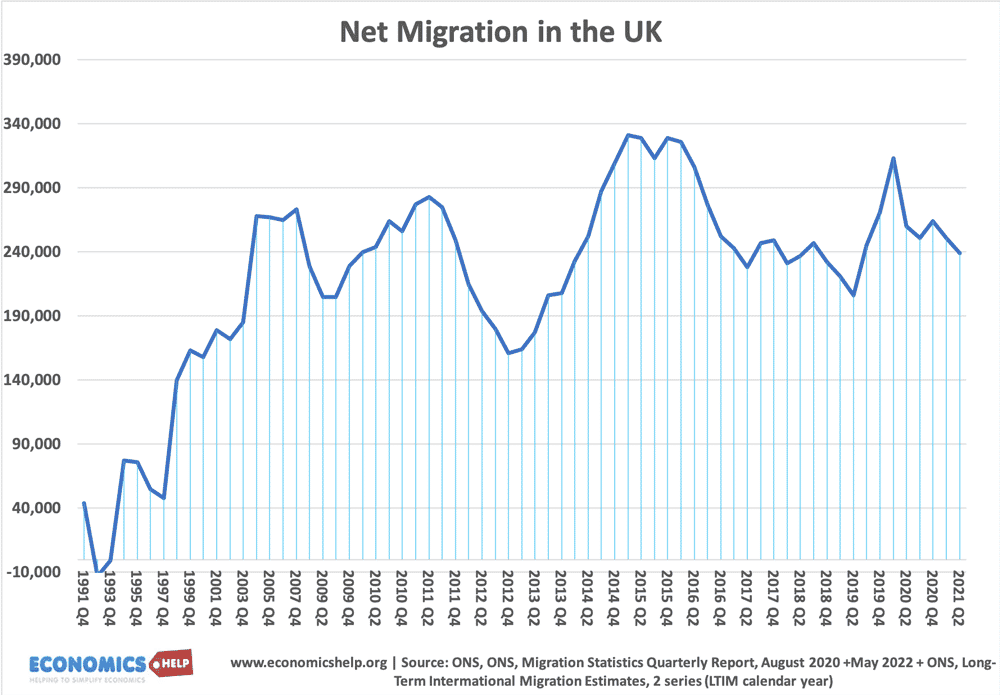
International Migration ONS
- In 2021, Net long-term international migration was estimated to be +238,000 in 2016.
- In 2021 Q4, there were 18.766 applications for asylum.
- In 2019, there were 9.5 million people born outside the UK (estimated 14% of the UK’s population.) (5.8 million, non-EU, 3.6 million EU)
Inflows and Outflows
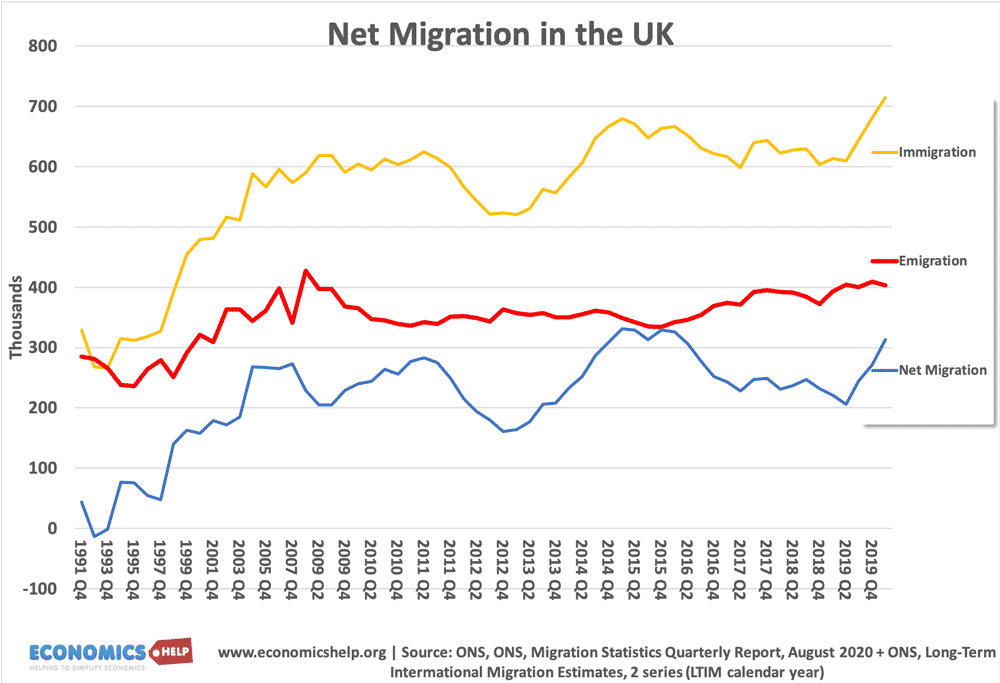
- In 2019, the top 6 countries for the source of migrants was India, Poland, Pakistan, Romania, Ireland.
EU vs Non-EU immigration
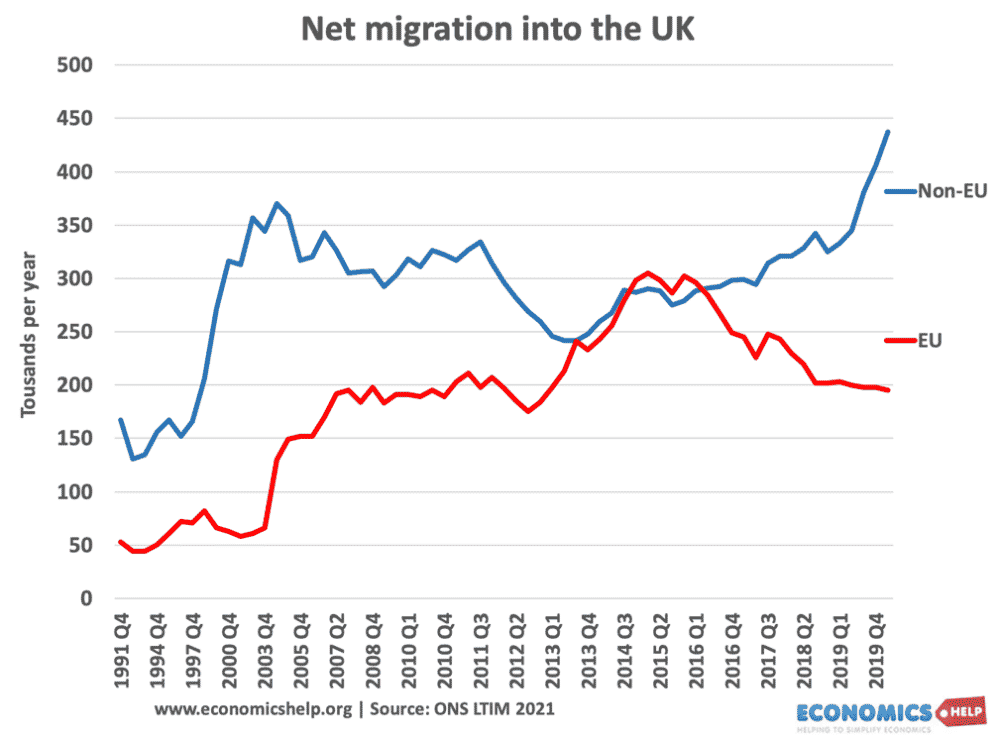
Traditionally non-EU immigrants are more likely to come for family reasons, whilst EU migration has been focused on work.
Impact of Net Immigration on UK Economy
1. Increase in Labour Force
Migrants are more likely to be of working age. The majority of migrants come for work or study (students) They may bring dependents, but generally net immigration leads to an increase in the labour force, a decline in the dependency ratio and increases the potential output capacity of the economy.
2. Increase in aggregate demand and Real GDP
Net inflows of people also lead to an increase in aggregate demand. Migrants will increase the total spending within the economy. As well as increasing the supply of labour, there will be an increase in the demand for labour – relating to the increased spending within the economy. Ceteris paribus , net migration should lead to an increase in real GDP. The impact on real GDP per capita is less certain.
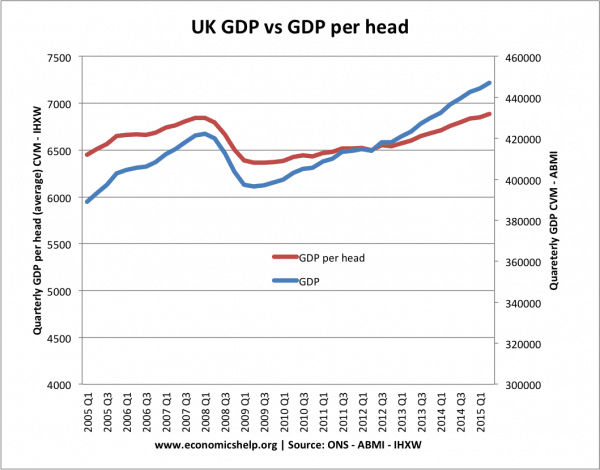
In fact, net migration can make economic growth look stronger than it is. In the period 2005-2015, UK real GDP has increased significantly faster than GDP per head. See GDP per capita for more info.
3. Labour Market Flexibility
Net migration could create a more flexible labour market. Migrants will be particularly attracted to move to the UK if they feel that there are job vacancies in particular areas. For example, during the mid-2000s, there was a large inflow of workers from Poland and other Eastern European economies – helping to meet the demand for semi-skilled jobs, such as builders and plumbers. The government has also sought to attract migrants from various countries to meet shortfalls in job vacancies in key public sector jobs, such as nursing.
- In theory, a period of higher unemployment might discourage migrants (this has occurred in the case of Ireland). However, the UK aw continued net migration despite higher unemployment 2008-12. Since 2012, unemployment has fallen considerably and migration has remained fairly constant.
4. Positive impact on the dependency ratio
With an ageing population, the UK is forecast to see an increase in the dependency ratio . However, net migration helps to reduce the dependency ratio. Migrants are more likely to be a source of working-age people, and this helps to reduce the ratio of retired to working people. The Migration Observatory reports, that in 2019, 70% of the foreign born were aged 26-64, compared to 48% of the UK born ( link) . This younger population has benefits for the government’s budget. If migrants are of working age, they will pay income tax, VAT – but will not be claiming benefits.
5. Impact on particular sectors
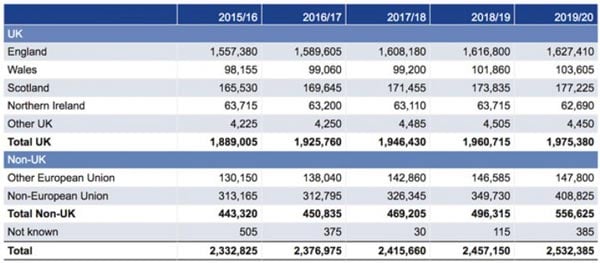
An important reason for net migration is higher education. In 2019/20, according to Higher Education Statistics Agency (HESA) there were 556,625 international students ( link ), studying in the UK. These students may not show up in long-term migration trends. But, the short-term effects are quite important. The London Economic analysis estimate that students of 2018-19 contributed a net £25.9 billion to the UK economy ( link – pdf) . A very significant contribution. These payments also help to finance higher education for domestic students.
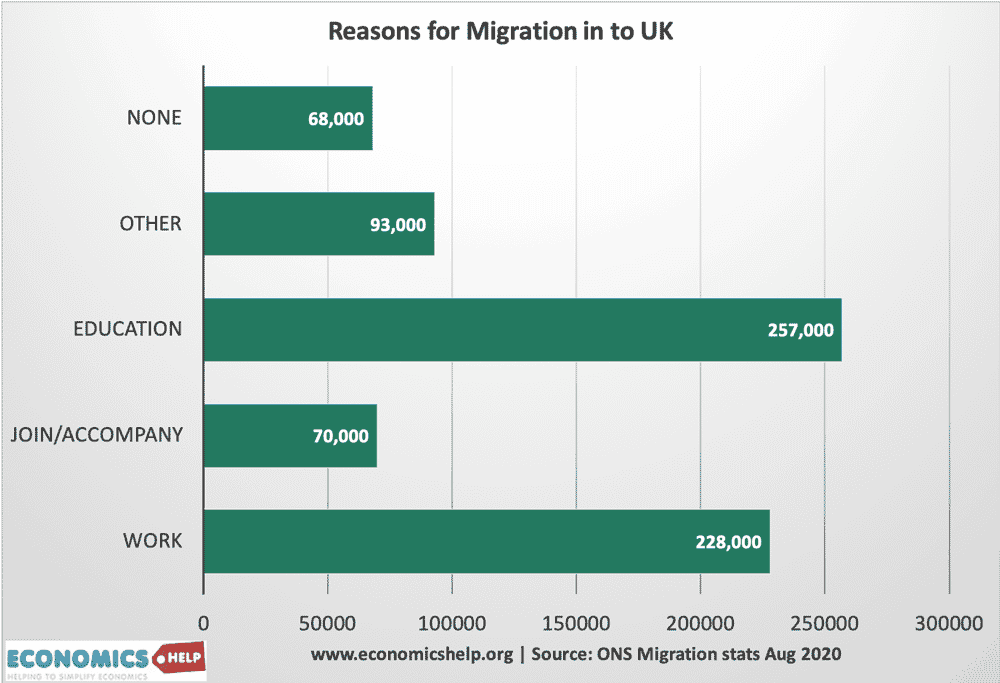
The latest ONS report suggests formal study is the biggest reason for net migration into the UK. See also: reasons for net migration into the UK
6. Social issues
Another issue felt keenly in the UK, is the concept that we are already ‘overcrowded’ In this case, a rapid increase in the population due to migration could lead to falling living standards. For example, the UK faces an acute housing shortage, but also an unwillingness to build on increasingly scarce green belt land. In many cities, it is difficult to build more roads because of limited space. The increased population could increase congestion and urban pollution. Therefore, the increase in real GDP has to be measured against these issues which affect the quality of life.
7. Economies of scale
Others may argue that concepts of ‘overcrowding’ are misplaced. In the nineteenth century, people were already worried about overcrowding. But higher population densities are in one sense more efficient and have a lower environmental impact. Other countries like Belgium have an even greater population density than the UK. Also, if migrants help to grow the economy, there will be more tax revenue to finance public infrastructure.
8. Welfare benefits
A popular idea is that immigrants are more likely to receive welfare benefits and social housing. The suggestion is that Britain’s generous welfare state provides an incentive for people to come from Eastern Europe and receive housing and welfare benefits. While immigrants can end up receiving benefits and social housing. A report by the University College of London, suggests that :
- However, despite the positive figures in the decade since the millennium, the study found that between 1995 and 2011, immigrants from non-EEA countries claimed more in benefits than they paid in taxes, mainly because they tended to have more children than native Britons.
In recent years, claiming unemployment benefits in the UK is quite strict – the claimant count measure of unemployment is much less than the labour force survey (see: Unemployment stats ). People have to prove they are looking for work. Also, the criteria to be given an immigration visa from non-EU countries is increasingly strict. The migrant often have to show they have a degree of savings or an offer of a good job. The UCL report on immigration suggested that immigrants tend to be more highly skilled than native workers.
- In 2011, 32% of recent EEA immigrants and 43% of non-EEA immigrants had university degrees, compared with 21% of the British adult population.
Does Immigration Cause Unemployment?
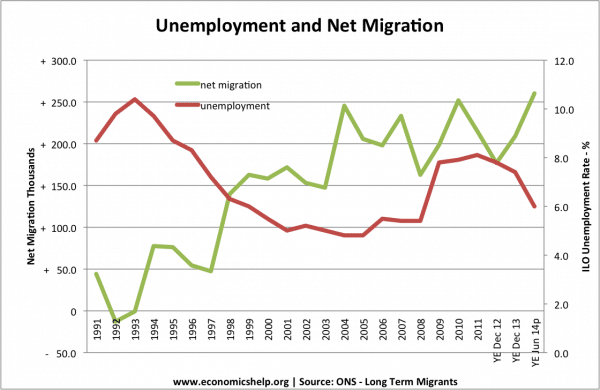
No clear link between migration and unemployment. Net migration occurred with falling unemployment 1991-2005, but rising unemployment from 2008-12. The fall in unemployment since 2012 may have attracted more migrants coming to work.
A common question people often ask – is whether immigration causes unemployment? Migrants have often been blamed for ‘taking our jobs’ – especially in periods of high unemployment, and in local areas of above-average unemployment.
Firstly, net migration is compatible with low unemployment. Net migration helped the US population to increase drastically around the turn of the century, but this didn’t cause unemployment. Migrants bring both an increased supply of labour and higher demand for labour. In the 1990s, net migration was consistent with falling unemployment in the UK.
However, in periods of high unemployment, it may be much more difficult for migrants to find work. This may be exacerbated if the migrants have poor English, low skills and or suffer racial discrimination. In this case, net migration could add to the unemployment problem. However, the underlying cause of unemployment is not net migration, but the recession.
Another factor that determines the impact on unemployment is the skills and qualifications of immigrants. If migrants have low skills, they are more likely to experience structural unemployment. In the 1950s, immigration into the UK from the Caribbean was encouraged for manual labour (driving buses e.t.c.) to fill job vacancies. However, when the period of full employment ends, migrants may be more liable to be unemployed, if they lack the skills to find new work.
The impact on unemployment in the current crisis depends on the type and skills of workers who are migrating into the UK.
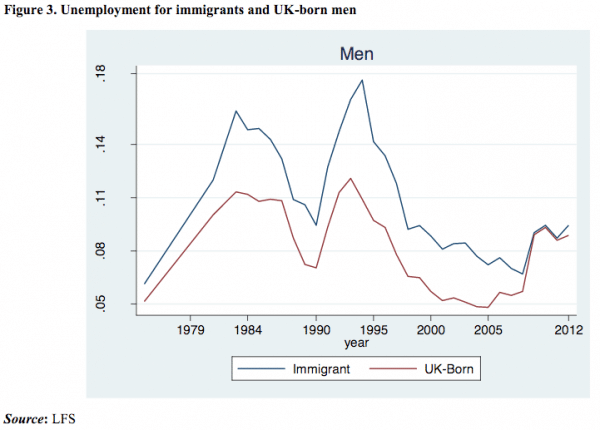
This shows that the unemployment rate for immigrants tends to be higher than for UK born workers. This gap is especially true during recessions. One reason put forward is that immigrants tend to be more likely to be working on short-term contracts, and so in a downturn are more likely to be laid off.
Does Immigration Push Down Wages?
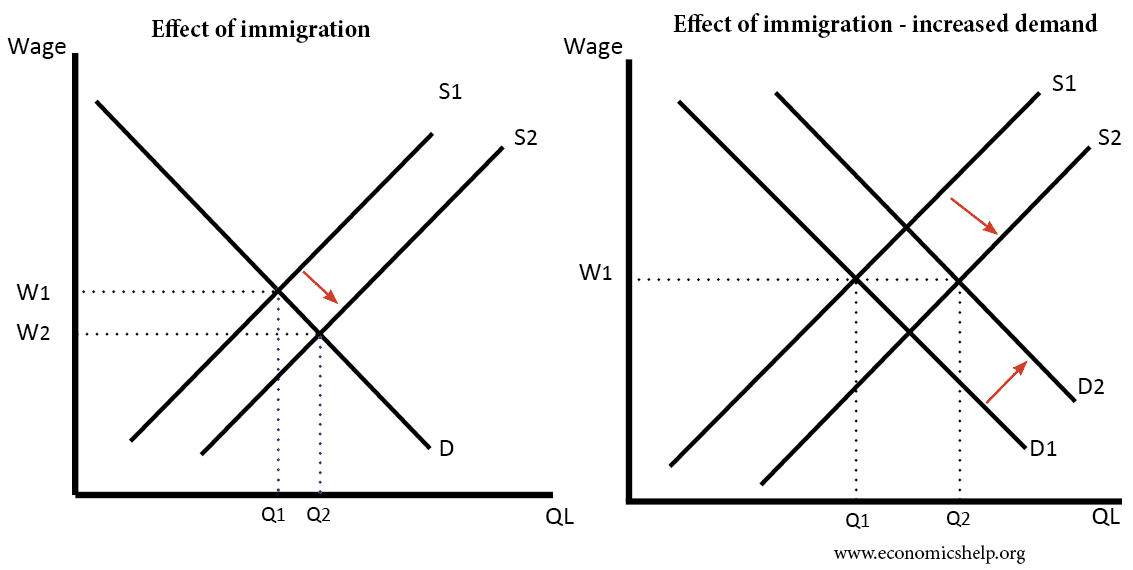
From one perspective an increase in the labour supply may push down wages. This is especially true if migrants are keen to accept lower wages (e.g. willing to bypass traditional union bargaining). However, again, net migration doesn’t have to push down wages. The massive immigration into the US, during the twentieth century, was consistent with rising real wages. Increased migration, will also affect demand for labour due to higher spending in the economy. Immigration increases labour supply – but also increased labour demand.
However, particular labour markets may notice lower wages if there is a concentration of immigrants willing to work. For example, if wages are high in a particular agricultural market, migration from a low-income country may lead to falling wages in these specific markets.
Also, some migrants may be more vulnerable and more willing to work in the black market (e.g. accept a wage below the equilibrium).
Further reading: Lump of labour fallacy – the fallacy that increased labour supply always pushes down wages.
Bank of England study on wages and immigration
A Bank of England found a rise in immigration had a tiny impact on overall wages – with a 10% increase in immigration – wages fall by 0.31%. However, the negative effect was greater for semi/unskilled workers in the service sector, with a 10% rise in immigration reducing wages the equivalent of 2%. B of E report. However, this explains only a small fraction of the real wage decline since 2007.
- What explains fall in real wages since 2007/08?
Video on Immigration
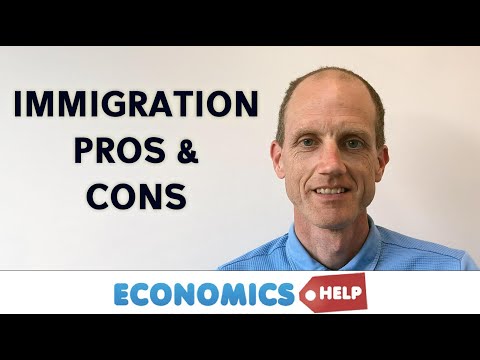
Evaluation of Immigration
The impact of net immigration depends on:
- The skills and qualifications of migrants. The UK is increasingly strict on allowing only skilled workers.
- How easy do migrant find it to assimilate in the destined country? E.g. in the 1950s and 1960s, migrants from the Indian sub-continent / Caribbean may have found it more difficult to find employment due to poor English / racial discrimination.
- It depends on the age profile of migrants. If a high % are young workers, then this can help reduce the dependency ratio – a crucial issue for the government budget.
- It depends on the current economic climate. In a recession, migrants will find it harder to gain employment.
- It depends on the type and skills of migrants. Migrants from Eastern Europe may be more flexible and return home if the economic situation deteriorates. Low skilled migrants are more likely to be structurally unemployed.
- Migrants can be a source of foreign income, e.g. tuition fees from foreign students. However, migrants may also send a substantial portion of their earnings to relatives abroad – reducing the wealth of UK.
- Can the Economy absorb a greater population? For example, what are the impact on public services, levels of congestion, and housing?
Impact of Immigration on housing
Positive net migration levels are a significant factor in increasing the number of households in the UK. Given limited housing supply (and difficulties of increasing supply), this is putting upward pressure on UK house prices and the price of renting.
See: Immigration and housing
- Reasons for net migration into the UK
- Immigration and the black market
- Flexible labour markets and immigration
- Long-term migrants data at ONS
NOTE: EEA – European Economic Area – EU, plus EFTA countries Norway, Iceland and Liechtenstein.
78 thoughts on “Impact of Immigration on UK Economy”
Your posts are very instructive, which I later learned a lot from. It was great I hope you get more new posts! beautiful article
More cheap expandable Labour = less incentive for companies to invest in technology. They would rather hire and fire cheap Labour from less developed countries. That means a lot more people doing something that someone with the right tools could get done themselves.
Thank you for your suggestion Preeti, we will try to explain in a more specific way on our future articles.
good post. I just stumbled upon your blog and wanted to say that I have really enjoyed reading your blog posts.
Really good article, thank you for sharing
Nice and helpful post for me. Thanks
This really helpful. Thank you
the good blog, the Leave a Legacy is not going away forever.
Your blog is very informative. thanks for Sharing this blog.
I am worndering to find such an informative content . thank you
I am worndering to find such an informative content . thank you for This article
Hi, I’d like to ask where you got the datasets for this. Interesting read by the way!
The UK has become a stagnating economy relying on cheap third world labor, this has destroyed all the innovation in the country. Just need to see the performance of the FTSE 100 to understand that the british economy hasn’t evolved since the 19th century, oil stocks, tobacco stocks, banks… The correlation of the charts of decelerating growth and increased migration shows it very well. The GDP growth is artificially maintained with migration but the reality says otherwise. People can barely house themselves in big cities, wages have been stagnating for two decades. It’s useless to look at absolute numbers PPP GDP already tells you more. And we are not even talking about the human costs of living in cities where the autochthonous european people are now just small minorities and being replaced by cheap labor forces. This situation comes from the lack of courage of governments and also the people who voted them into office. The decline will not stop, it will be slow and painful.
very nice blog for sharing
Comments are closed.
Consulting | 18 Sep 2018
The Fiscal Impact of Immigration on the UK
Economic Consulting Team
Oxford Economics

European migrants living in the UK contribute £2,300 more to public purse each year than the average adult, suggesting a net contribution of £78,000 to the exchequer over their lifespan in the UK.
In preparation for Brexit, the government asked its Migration Advisory Committee (MAC) to report on the economic and social impacts of EU migrants in the UK. The MAC commissioned Oxford Economics to analyse the fiscal implications of immigration using the most up-to-date data and sophisticated modelling techniques.
The resulting study, The Fiscal Impact of Immigration on the UK, represents the most comprehensive assessment to date of the net contribution that all migrants make to the UK’s public finances.
The study finds that
- The average UK-based migrant from Europe contributed approximately £2,300 more to UK public finances in 2016/17 than the average UK adult. In comparison, each UK born adult contributed £70 less than the average, and each non-European migrant contributed over £800 less than the average.
- The average European migrant arriving in the UK in 2016 will contribute £78,000 more than they take out in public services and benefits over their time spent in the UK (assuming a balanced national budget), and the average non-European migrant will make a positive net contribution of £28,000 while living here. By comparison, the average UK citizen’s net lifetime contribution in this scenario is zero.
- Taken together, this means that the migrants who arrived in 2016 will make a total net positive contribution of £26.9 billion to the UK’s public finances over the entirety of their stay. The value of this to the UK’s public finances is equivalent to putting approximately 5p on income tax rates (across all marginal rate bands) in that year.
About the team
Our economic consulting team are world leaders in quantitative economic analysis, working with clients around the globe and across sectors to build models, forecast markets and evaluate interventions using state-of-the art techniques.
Related Services

Boosting Accommodation Supply and Affordability During Major Events
Flexible accommodation solutions made available on Airbnb enable destinations to host events, enhancing visitor experience and bolstering local economies.

Reinvent for growth in the media industry: Only the radical will survive and thrive
In partnership with Accenture, Oxford Economics surveyed 6,000 consumers across 10 countries to better understand their preferences, beliefs, and behaviors toward their online entertainment experiences. Lead researcher, Sundus Alfi, discusses the results of this research with Marketplace, citing customer expectations for a seamless viewing experience.

Climate Change and Food Prices in Southeast Asia: 2024 Update
This report highlights the vulnerability of food production cost in ASEAN given the impending physical and transition risks of climate change. It also highlights the critical policy response at domestic and international level to support the transition.
Select to close video modal
Select to close video modal Play Video Select to play video
- Search Menu
- Sign in through your institution
- Advance articles
- Featured articles
- Virtual Issues
- Prize-Winning Articles
- Browse content in A - General Economics and Teaching
- Browse content in A1 - General Economics
- A11 - Role of Economics; Role of Economists; Market for Economists
- A12 - Relation of Economics to Other Disciplines
- Browse content in B - History of Economic Thought, Methodology, and Heterodox Approaches
- Browse content in B4 - Economic Methodology
- B41 - Economic Methodology
- Browse content in C - Mathematical and Quantitative Methods
- Browse content in C1 - Econometric and Statistical Methods and Methodology: General
- C10 - General
- C11 - Bayesian Analysis: General
- C12 - Hypothesis Testing: General
- C13 - Estimation: General
- C14 - Semiparametric and Nonparametric Methods: General
- C18 - Methodological Issues: General
- Browse content in C2 - Single Equation Models; Single Variables
- C22 - Time-Series Models; Dynamic Quantile Regressions; Dynamic Treatment Effect Models; Diffusion Processes
- C23 - Panel Data Models; Spatio-temporal Models
- C26 - Instrumental Variables (IV) Estimation
- Browse content in C3 - Multiple or Simultaneous Equation Models; Multiple Variables
- C31 - Cross-Sectional Models; Spatial Models; Treatment Effect Models; Quantile Regressions; Social Interaction Models
- C32 - Time-Series Models; Dynamic Quantile Regressions; Dynamic Treatment Effect Models; Diffusion Processes; State Space Models
- C33 - Panel Data Models; Spatio-temporal Models
- C36 - Instrumental Variables (IV) Estimation
- Browse content in C4 - Econometric and Statistical Methods: Special Topics
- C40 - General
- C44 - Operations Research; Statistical Decision Theory
- C45 - Neural Networks and Related Topics
- C49 - Other
- Browse content in C5 - Econometric Modeling
- C52 - Model Evaluation, Validation, and Selection
- C53 - Forecasting and Prediction Methods; Simulation Methods
- C55 - Large Data Sets: Modeling and Analysis
- Browse content in C6 - Mathematical Methods; Programming Models; Mathematical and Simulation Modeling
- C61 - Optimization Techniques; Programming Models; Dynamic Analysis
- C62 - Existence and Stability Conditions of Equilibrium
- C63 - Computational Techniques; Simulation Modeling
- Browse content in C7 - Game Theory and Bargaining Theory
- C70 - General
- C71 - Cooperative Games
- C72 - Noncooperative Games
- C73 - Stochastic and Dynamic Games; Evolutionary Games; Repeated Games
- C78 - Bargaining Theory; Matching Theory
- Browse content in C8 - Data Collection and Data Estimation Methodology; Computer Programs
- C81 - Methodology for Collecting, Estimating, and Organizing Microeconomic Data; Data Access
- Browse content in C9 - Design of Experiments
- C90 - General
- C91 - Laboratory, Individual Behavior
- C92 - Laboratory, Group Behavior
- C93 - Field Experiments
- C99 - Other
- Browse content in D - Microeconomics
- Browse content in D0 - General
- D00 - General
- D01 - Microeconomic Behavior: Underlying Principles
- D02 - Institutions: Design, Formation, Operations, and Impact
- D03 - Behavioral Microeconomics: Underlying Principles
- Browse content in D1 - Household Behavior and Family Economics
- D11 - Consumer Economics: Theory
- D12 - Consumer Economics: Empirical Analysis
- D13 - Household Production and Intrahousehold Allocation
- D14 - Household Saving; Personal Finance
- D15 - Intertemporal Household Choice: Life Cycle Models and Saving
- D18 - Consumer Protection
- Browse content in D2 - Production and Organizations
- D21 - Firm Behavior: Theory
- D22 - Firm Behavior: Empirical Analysis
- D23 - Organizational Behavior; Transaction Costs; Property Rights
- D24 - Production; Cost; Capital; Capital, Total Factor, and Multifactor Productivity; Capacity
- Browse content in D3 - Distribution
- D30 - General
- D31 - Personal Income, Wealth, and Their Distributions
- D33 - Factor Income Distribution
- Browse content in D4 - Market Structure, Pricing, and Design
- D40 - General
- D42 - Monopoly
- D43 - Oligopoly and Other Forms of Market Imperfection
- D44 - Auctions
- D47 - Market Design
- Browse content in D5 - General Equilibrium and Disequilibrium
- D50 - General
- D52 - Incomplete Markets
- Browse content in D6 - Welfare Economics
- D60 - General
- D61 - Allocative Efficiency; Cost-Benefit Analysis
- D62 - Externalities
- D63 - Equity, Justice, Inequality, and Other Normative Criteria and Measurement
- D64 - Altruism; Philanthropy
- Browse content in D7 - Analysis of Collective Decision-Making
- D70 - General
- D71 - Social Choice; Clubs; Committees; Associations
- D72 - Political Processes: Rent-seeking, Lobbying, Elections, Legislatures, and Voting Behavior
- D73 - Bureaucracy; Administrative Processes in Public Organizations; Corruption
- D74 - Conflict; Conflict Resolution; Alliances; Revolutions
- D78 - Positive Analysis of Policy Formulation and Implementation
- Browse content in D8 - Information, Knowledge, and Uncertainty
- D80 - General
- D81 - Criteria for Decision-Making under Risk and Uncertainty
- D82 - Asymmetric and Private Information; Mechanism Design
- D83 - Search; Learning; Information and Knowledge; Communication; Belief; Unawareness
- D84 - Expectations; Speculations
- D85 - Network Formation and Analysis: Theory
- D86 - Economics of Contract: Theory
- D87 - Neuroeconomics
- D89 - Other
- Browse content in D9 - Micro-Based Behavioral Economics
- D90 - General
- D91 - Role and Effects of Psychological, Emotional, Social, and Cognitive Factors on Decision Making
- D92 - Intertemporal Firm Choice, Investment, Capacity, and Financing
- Browse content in E - Macroeconomics and Monetary Economics
- Browse content in E0 - General
- E01 - Measurement and Data on National Income and Product Accounts and Wealth; Environmental Accounts
- E02 - Institutions and the Macroeconomy
- E1 - General Aggregative Models
- Browse content in E2 - Consumption, Saving, Production, Investment, Labor Markets, and Informal Economy
- E20 - General
- E21 - Consumption; Saving; Wealth
- E22 - Investment; Capital; Intangible Capital; Capacity
- E23 - Production
- E24 - Employment; Unemployment; Wages; Intergenerational Income Distribution; Aggregate Human Capital; Aggregate Labor Productivity
- E25 - Aggregate Factor Income Distribution
- E26 - Informal Economy; Underground Economy
- E27 - Forecasting and Simulation: Models and Applications
- Browse content in E3 - Prices, Business Fluctuations, and Cycles
- E30 - General
- E31 - Price Level; Inflation; Deflation
- E32 - Business Fluctuations; Cycles
- E37 - Forecasting and Simulation: Models and Applications
- Browse content in E4 - Money and Interest Rates
- E43 - Interest Rates: Determination, Term Structure, and Effects
- E44 - Financial Markets and the Macroeconomy
- Browse content in E5 - Monetary Policy, Central Banking, and the Supply of Money and Credit
- E51 - Money Supply; Credit; Money Multipliers
- E52 - Monetary Policy
- E58 - Central Banks and Their Policies
- Browse content in E6 - Macroeconomic Policy, Macroeconomic Aspects of Public Finance, and General Outlook
- E61 - Policy Objectives; Policy Designs and Consistency; Policy Coordination
- E62 - Fiscal Policy
- E63 - Comparative or Joint Analysis of Fiscal and Monetary Policy; Stabilization; Treasury Policy
- E65 - Studies of Particular Policy Episodes
- Browse content in F - International Economics
- Browse content in F0 - General
- F01 - Global Outlook
- F02 - International Economic Order and Integration
- Browse content in F1 - Trade
- F10 - General
- F11 - Neoclassical Models of Trade
- F12 - Models of Trade with Imperfect Competition and Scale Economies; Fragmentation
- F13 - Trade Policy; International Trade Organizations
- F14 - Empirical Studies of Trade
- F15 - Economic Integration
- F16 - Trade and Labor Market Interactions
- F17 - Trade Forecasting and Simulation
- Browse content in F2 - International Factor Movements and International Business
- F20 - General
- F21 - International Investment; Long-Term Capital Movements
- F22 - International Migration
- F23 - Multinational Firms; International Business
- Browse content in F3 - International Finance
- F31 - Foreign Exchange
- F32 - Current Account Adjustment; Short-Term Capital Movements
- F33 - International Monetary Arrangements and Institutions
- F34 - International Lending and Debt Problems
- F35 - Foreign Aid
- Browse content in F4 - Macroeconomic Aspects of International Trade and Finance
- F41 - Open Economy Macroeconomics
- F42 - International Policy Coordination and Transmission
- F43 - Economic Growth of Open Economies
- F45 - Macroeconomic Issues of Monetary Unions
- Browse content in F5 - International Relations, National Security, and International Political Economy
- F50 - General
- F51 - International Conflicts; Negotiations; Sanctions
- F52 - National Security; Economic Nationalism
- F55 - International Institutional Arrangements
- Browse content in F6 - Economic Impacts of Globalization
- F60 - General
- F61 - Microeconomic Impacts
- F66 - Labor
- F68 - Policy
- Browse content in G - Financial Economics
- Browse content in G0 - General
- G01 - Financial Crises
- Browse content in G1 - General Financial Markets
- G10 - General
- G11 - Portfolio Choice; Investment Decisions
- G12 - Asset Pricing; Trading volume; Bond Interest Rates
- G15 - International Financial Markets
- Browse content in G2 - Financial Institutions and Services
- G20 - General
- G21 - Banks; Depository Institutions; Micro Finance Institutions; Mortgages
- G24 - Investment Banking; Venture Capital; Brokerage; Ratings and Ratings Agencies
- G28 - Government Policy and Regulation
- Browse content in G3 - Corporate Finance and Governance
- G30 - General
- G31 - Capital Budgeting; Fixed Investment and Inventory Studies; Capacity
- G32 - Financing Policy; Financial Risk and Risk Management; Capital and Ownership Structure; Value of Firms; Goodwill
- G33 - Bankruptcy; Liquidation
- G34 - Mergers; Acquisitions; Restructuring; Corporate Governance
- Browse content in G4 - Behavioral Finance
- G41 - Role and Effects of Psychological, Emotional, Social, and Cognitive Factors on Decision Making in Financial Markets
- Browse content in G5 - Household Finance
- G51 - Household Saving, Borrowing, Debt, and Wealth
- G53 - Financial Literacy
- Browse content in H - Public Economics
- Browse content in H0 - General
- H00 - General
- Browse content in H1 - Structure and Scope of Government
- H11 - Structure, Scope, and Performance of Government
- H12 - Crisis Management
- Browse content in H2 - Taxation, Subsidies, and Revenue
- H20 - General
- H21 - Efficiency; Optimal Taxation
- H22 - Incidence
- H23 - Externalities; Redistributive Effects; Environmental Taxes and Subsidies
- H24 - Personal Income and Other Nonbusiness Taxes and Subsidies; includes inheritance and gift taxes
- H25 - Business Taxes and Subsidies
- H26 - Tax Evasion and Avoidance
- Browse content in H3 - Fiscal Policies and Behavior of Economic Agents
- H30 - General
- H31 - Household
- Browse content in H4 - Publicly Provided Goods
- H41 - Public Goods
- H42 - Publicly Provided Private Goods
- H44 - Publicly Provided Goods: Mixed Markets
- Browse content in H5 - National Government Expenditures and Related Policies
- H50 - General
- H51 - Government Expenditures and Health
- H52 - Government Expenditures and Education
- H53 - Government Expenditures and Welfare Programs
- H54 - Infrastructures; Other Public Investment and Capital Stock
- H55 - Social Security and Public Pensions
- H56 - National Security and War
- H57 - Procurement
- Browse content in H6 - National Budget, Deficit, and Debt
- H62 - Deficit; Surplus
- H63 - Debt; Debt Management; Sovereign Debt
- H68 - Forecasts of Budgets, Deficits, and Debt
- Browse content in H7 - State and Local Government; Intergovernmental Relations
- H71 - State and Local Taxation, Subsidies, and Revenue
- H72 - State and Local Budget and Expenditures
- H75 - State and Local Government: Health; Education; Welfare; Public Pensions
- H76 - State and Local Government: Other Expenditure Categories
- H77 - Intergovernmental Relations; Federalism; Secession
- Browse content in H8 - Miscellaneous Issues
- H87 - International Fiscal Issues; International Public Goods
- Browse content in I - Health, Education, and Welfare
- Browse content in I1 - Health
- I10 - General
- I11 - Analysis of Health Care Markets
- I12 - Health Behavior
- I14 - Health and Inequality
- I15 - Health and Economic Development
- I18 - Government Policy; Regulation; Public Health
- I19 - Other
- Browse content in I2 - Education and Research Institutions
- I20 - General
- I21 - Analysis of Education
- I22 - Educational Finance; Financial Aid
- I23 - Higher Education; Research Institutions
- I24 - Education and Inequality
- I25 - Education and Economic Development
- I26 - Returns to Education
- I28 - Government Policy
- Browse content in I3 - Welfare, Well-Being, and Poverty
- I30 - General
- I31 - General Welfare
- I32 - Measurement and Analysis of Poverty
- I38 - Government Policy; Provision and Effects of Welfare Programs
- Browse content in J - Labor and Demographic Economics
- Browse content in J0 - General
- J00 - General
- J01 - Labor Economics: General
- J08 - Labor Economics Policies
- Browse content in J1 - Demographic Economics
- J10 - General
- J11 - Demographic Trends, Macroeconomic Effects, and Forecasts
- J12 - Marriage; Marital Dissolution; Family Structure; Domestic Abuse
- J13 - Fertility; Family Planning; Child Care; Children; Youth
- J14 - Economics of the Elderly; Economics of the Handicapped; Non-Labor Market Discrimination
- J15 - Economics of Minorities, Races, Indigenous Peoples, and Immigrants; Non-labor Discrimination
- J16 - Economics of Gender; Non-labor Discrimination
- J17 - Value of Life; Forgone Income
- J18 - Public Policy
- Browse content in J2 - Demand and Supply of Labor
- J20 - General
- J21 - Labor Force and Employment, Size, and Structure
- J22 - Time Allocation and Labor Supply
- J23 - Labor Demand
- J24 - Human Capital; Skills; Occupational Choice; Labor Productivity
- J26 - Retirement; Retirement Policies
- J28 - Safety; Job Satisfaction; Related Public Policy
- Browse content in J3 - Wages, Compensation, and Labor Costs
- J31 - Wage Level and Structure; Wage Differentials
- J32 - Nonwage Labor Costs and Benefits; Retirement Plans; Private Pensions
- J33 - Compensation Packages; Payment Methods
- Browse content in J4 - Particular Labor Markets
- J42 - Monopsony; Segmented Labor Markets
- J43 - Agricultural Labor Markets
- J45 - Public Sector Labor Markets
- J46 - Informal Labor Markets
- J47 - Coercive Labor Markets
- Browse content in J5 - Labor-Management Relations, Trade Unions, and Collective Bargaining
- J50 - General
- J51 - Trade Unions: Objectives, Structure, and Effects
- J53 - Labor-Management Relations; Industrial Jurisprudence
- Browse content in J6 - Mobility, Unemployment, Vacancies, and Immigrant Workers
- J61 - Geographic Labor Mobility; Immigrant Workers
- J62 - Job, Occupational, and Intergenerational Mobility
- J63 - Turnover; Vacancies; Layoffs
- J64 - Unemployment: Models, Duration, Incidence, and Job Search
- J65 - Unemployment Insurance; Severance Pay; Plant Closings
- J68 - Public Policy
- Browse content in J7 - Labor Discrimination
- J71 - Discrimination
- Browse content in K - Law and Economics
- Browse content in K1 - Basic Areas of Law
- K10 - General
- K12 - Contract Law
- K14 - Criminal Law
- Browse content in K3 - Other Substantive Areas of Law
- K36 - Family and Personal Law
- Browse content in K4 - Legal Procedure, the Legal System, and Illegal Behavior
- K40 - General
- K41 - Litigation Process
- K42 - Illegal Behavior and the Enforcement of Law
- Browse content in L - Industrial Organization
- Browse content in L0 - General
- L00 - General
- Browse content in L1 - Market Structure, Firm Strategy, and Market Performance
- L11 - Production, Pricing, and Market Structure; Size Distribution of Firms
- L12 - Monopoly; Monopolization Strategies
- L13 - Oligopoly and Other Imperfect Markets
- L14 - Transactional Relationships; Contracts and Reputation; Networks
- L15 - Information and Product Quality; Standardization and Compatibility
- L16 - Industrial Organization and Macroeconomics: Industrial Structure and Structural Change; Industrial Price Indices
- Browse content in L2 - Firm Objectives, Organization, and Behavior
- L22 - Firm Organization and Market Structure
- L25 - Firm Performance: Size, Diversification, and Scope
- L26 - Entrepreneurship
- Browse content in L3 - Nonprofit Organizations and Public Enterprise
- L31 - Nonprofit Institutions; NGOs; Social Entrepreneurship
- L32 - Public Enterprises; Public-Private Enterprises
- L33 - Comparison of Public and Private Enterprises and Nonprofit Institutions; Privatization; Contracting Out
- Browse content in L4 - Antitrust Issues and Policies
- L41 - Monopolization; Horizontal Anticompetitive Practices
- L42 - Vertical Restraints; Resale Price Maintenance; Quantity Discounts
- L44 - Antitrust Policy and Public Enterprises, Nonprofit Institutions, and Professional Organizations
- Browse content in L5 - Regulation and Industrial Policy
- L51 - Economics of Regulation
- L52 - Industrial Policy; Sectoral Planning Methods
- Browse content in L6 - Industry Studies: Manufacturing
- L60 - General
- L66 - Food; Beverages; Cosmetics; Tobacco; Wine and Spirits
- L67 - Other Consumer Nondurables: Clothing, Textiles, Shoes, and Leather Goods; Household Goods; Sports Equipment
- Browse content in L8 - Industry Studies: Services
- L81 - Retail and Wholesale Trade; e-Commerce
- L82 - Entertainment; Media
- L83 - Sports; Gambling; Recreation; Tourism
- L86 - Information and Internet Services; Computer Software
- Browse content in L9 - Industry Studies: Transportation and Utilities
- L91 - Transportation: General
- L94 - Electric Utilities
- L96 - Telecommunications
- L98 - Government Policy
- Browse content in M - Business Administration and Business Economics; Marketing; Accounting; Personnel Economics
- Browse content in M1 - Business Administration
- M10 - General
- M12 - Personnel Management; Executives; Executive Compensation
- M13 - New Firms; Startups
- Browse content in M2 - Business Economics
- M21 - Business Economics
- Browse content in M3 - Marketing and Advertising
- M30 - General
- M31 - Marketing
- Browse content in M5 - Personnel Economics
- M50 - General
- M51 - Firm Employment Decisions; Promotions
- M52 - Compensation and Compensation Methods and Their Effects
- M55 - Labor Contracting Devices
- Browse content in N - Economic History
- Browse content in N1 - Macroeconomics and Monetary Economics; Industrial Structure; Growth; Fluctuations
- N10 - General, International, or Comparative
- N12 - U.S.; Canada: 1913-
- N13 - Europe: Pre-1913
- N14 - Europe: 1913-
- N15 - Asia including Middle East
- Browse content in N2 - Financial Markets and Institutions
- N20 - General, International, or Comparative
- N23 - Europe: Pre-1913
- N26 - Latin America; Caribbean
- Browse content in N3 - Labor and Consumers, Demography, Education, Health, Welfare, Income, Wealth, Religion, and Philanthropy
- N30 - General, International, or Comparative
- N32 - U.S.; Canada: 1913-
- N33 - Europe: Pre-1913
- N34 - Europe: 1913-
- N35 - Asia including Middle East
- Browse content in N4 - Government, War, Law, International Relations, and Regulation
- N40 - General, International, or Comparative
- N41 - U.S.; Canada: Pre-1913
- N42 - U.S.; Canada: 1913-
- N43 - Europe: Pre-1913
- N44 - Europe: 1913-
- N45 - Asia including Middle East
- Browse content in N5 - Agriculture, Natural Resources, Environment, and Extractive Industries
- N50 - General, International, or Comparative
- N51 - U.S.; Canada: Pre-1913
- N53 - Europe: Pre-1913
- N55 - Asia including Middle East
- N57 - Africa; Oceania
- Browse content in N6 - Manufacturing and Construction
- N63 - Europe: Pre-1913
- Browse content in N7 - Transport, Trade, Energy, Technology, and Other Services
- N70 - General, International, or Comparative
- N71 - U.S.; Canada: Pre-1913
- N72 - U.S.; Canada: 1913-
- N73 - Europe: Pre-1913
- N75 - Asia including Middle East
- Browse content in N9 - Regional and Urban History
- N90 - General, International, or Comparative
- N92 - U.S.; Canada: 1913-
- N94 - Europe: 1913-
- N95 - Asia including Middle East
- Browse content in O - Economic Development, Innovation, Technological Change, and Growth
- Browse content in O1 - Economic Development
- O10 - General
- O11 - Macroeconomic Analyses of Economic Development
- O12 - Microeconomic Analyses of Economic Development
- O13 - Agriculture; Natural Resources; Energy; Environment; Other Primary Products
- O14 - Industrialization; Manufacturing and Service Industries; Choice of Technology
- O15 - Human Resources; Human Development; Income Distribution; Migration
- O16 - Financial Markets; Saving and Capital Investment; Corporate Finance and Governance
- O17 - Formal and Informal Sectors; Shadow Economy; Institutional Arrangements
- O18 - Urban, Rural, Regional, and Transportation Analysis; Housing; Infrastructure
- O19 - International Linkages to Development; Role of International Organizations
- Browse content in O2 - Development Planning and Policy
- O22 - Project Analysis
- O24 - Trade Policy; Factor Movement Policy; Foreign Exchange Policy
- O25 - Industrial Policy
- Browse content in O3 - Innovation; Research and Development; Technological Change; Intellectual Property Rights
- O30 - General
- O31 - Innovation and Invention: Processes and Incentives
- O32 - Management of Technological Innovation and R&D
- O33 - Technological Change: Choices and Consequences; Diffusion Processes
- O34 - Intellectual Property and Intellectual Capital
- O38 - Government Policy
- O39 - Other
- Browse content in O4 - Economic Growth and Aggregate Productivity
- O40 - General
- O41 - One, Two, and Multisector Growth Models
- O43 - Institutions and Growth
- O44 - Environment and Growth
- O47 - Empirical Studies of Economic Growth; Aggregate Productivity; Cross-Country Output Convergence
- Browse content in O5 - Economywide Country Studies
- O50 - General
- O52 - Europe
- O53 - Asia including Middle East
- O55 - Africa
- Browse content in P - Economic Systems
- Browse content in P0 - General
- P00 - General
- Browse content in P1 - Capitalist Systems
- P14 - Property Rights
- P16 - Political Economy
- Browse content in P2 - Socialist Systems and Transitional Economies
- P26 - Political Economy; Property Rights
- Browse content in P3 - Socialist Institutions and Their Transitions
- P39 - Other
- Browse content in P4 - Other Economic Systems
- P48 - Political Economy; Legal Institutions; Property Rights; Natural Resources; Energy; Environment; Regional Studies
- Browse content in P5 - Comparative Economic Systems
- P50 - General
- P51 - Comparative Analysis of Economic Systems
- Browse content in Q - Agricultural and Natural Resource Economics; Environmental and Ecological Economics
- Browse content in Q1 - Agriculture
- Q12 - Micro Analysis of Farm Firms, Farm Households, and Farm Input Markets
- Q14 - Agricultural Finance
- Q15 - Land Ownership and Tenure; Land Reform; Land Use; Irrigation; Agriculture and Environment
- Q16 - R&D; Agricultural Technology; Biofuels; Agricultural Extension Services
- Q17 - Agriculture in International Trade
- Q18 - Agricultural Policy; Food Policy
- Browse content in Q2 - Renewable Resources and Conservation
- Q23 - Forestry
- Q28 - Government Policy
- Browse content in Q3 - Nonrenewable Resources and Conservation
- Q32 - Exhaustible Resources and Economic Development
- Q33 - Resource Booms
- Browse content in Q4 - Energy
- Q41 - Demand and Supply; Prices
- Q48 - Government Policy
- Browse content in Q5 - Environmental Economics
- Q51 - Valuation of Environmental Effects
- Q52 - Pollution Control Adoption Costs; Distributional Effects; Employment Effects
- Q53 - Air Pollution; Water Pollution; Noise; Hazardous Waste; Solid Waste; Recycling
- Q54 - Climate; Natural Disasters; Global Warming
- Q55 - Technological Innovation
- Q56 - Environment and Development; Environment and Trade; Sustainability; Environmental Accounts and Accounting; Environmental Equity; Population Growth
- Q58 - Government Policy
- Browse content in R - Urban, Rural, Regional, Real Estate, and Transportation Economics
- Browse content in R1 - General Regional Economics
- R10 - General
- R11 - Regional Economic Activity: Growth, Development, Environmental Issues, and Changes
- R12 - Size and Spatial Distributions of Regional Economic Activity
- R13 - General Equilibrium and Welfare Economic Analysis of Regional Economies
- R15 - Econometric and Input-Output Models; Other Models
- Browse content in R2 - Household Analysis
- R21 - Housing Demand
- R23 - Regional Migration; Regional Labor Markets; Population; Neighborhood Characteristics
- Browse content in R3 - Real Estate Markets, Spatial Production Analysis, and Firm Location
- R30 - General
- R31 - Housing Supply and Markets
- Browse content in R4 - Transportation Economics
- R41 - Transportation: Demand, Supply, and Congestion; Travel Time; Safety and Accidents; Transportation Noise
- Browse content in R5 - Regional Government Analysis
- R52 - Land Use and Other Regulations
- R58 - Regional Development Planning and Policy
- Browse content in Z - Other Special Topics
- Browse content in Z1 - Cultural Economics; Economic Sociology; Economic Anthropology
- Z10 - General
- Z12 - Religion
- Z13 - Economic Sociology; Economic Anthropology; Social and Economic Stratification
- Z19 - Other
- Browse content in Z2 - Sports Economics
- Z20 - General
- Author Guidelines
- Submission Site
- Open Access
- Self-Archiving Policy
- About The Economic Journal
- About the Royal Economic Society
- Editorial Board
- Advertising and Corporate Services
- Journals on Oxford Academic
- Books on Oxford Academic
- < Previous
The Fiscal Effects of Immigration to the UK
- Article contents
- Figures & tables
- Supplementary Data
Christian Dustmann, Tommaso Frattini, The Fiscal Effects of Immigration to the UK, The Economic Journal , Volume 124, Issue 580, November 2014, Pages F593–F643, https://doi.org/10.1111/ecoj.12181
- Permissions Icon Permissions
We investigate the fiscal impact of immigration on the UK economy, with a focus on the period since 1995. Our findings indicate that, when considering the resident immigrant population in each year from 1995 to 2011, immigrants from the European Economic Area (EEA) have made a positive fiscal contribution, even during periods when the UK was running budget deficits, while Non‐EEA immigrants, not dissimilar to natives, have made a negative contribution. For immigrants that arrived since 2000, contributions have been positive throughout, and particularly so for immigrants from EEA countries. Notable is the strong positive contribution made by immigrants from countries that joined the EU in 2004.
Email alerts
Citing articles via.
- Recommend to your Librarian
Affiliations
- Online ISSN 1468-0297
- Print ISSN 0013-0133
- Copyright © 2024 Royal Economic Society
- About Oxford Academic
- Publish journals with us
- University press partners
- What we publish
- New features
- Open access
- Institutional account management
- Rights and permissions
- Get help with access
- Accessibility
- Advertising
- Media enquiries
- Oxford University Press
- Oxford Languages
- University of Oxford
Oxford University Press is a department of the University of Oxford. It furthers the University's objective of excellence in research, scholarship, and education by publishing worldwide
- Copyright © 2024 Oxford University Press
- Cookie settings
- Cookie policy
- Privacy policy
- Legal notice
This Feature Is Available To Subscribers Only
Sign In or Create an Account
This PDF is available to Subscribers Only
For full access to this pdf, sign in to an existing account, or purchase an annual subscription.

- Terms and Conditions
- Privacy Policy
- Cookie policy
- Cancellation and Refund Policy
The Effect of Immigration on the UK Economy
At a time when immigration to the U.K. has reached a new peak , it is natural that conversations arise regarding the effect this will have on the United Kingdom. When these discussions are twinned with a growing cost of living crisis, it’s no surprise that these conversations then begin to focus on the effect of increased immigration on the economy.
In this article, we intend to examine the statistics that demonstrate the current effect of immigration on the U.K. economy, presenting a factual and straightforward assessment of the situation using both presently available and historical data. We hope this will enable those with concerns to gain further understanding.
Read our 899 reviews

Effects on the Tourism Sector
One of the least discussed elements of immigration to the U.K., but also the most prevalent, is tourism, with 49% of all visas in 2022 being classed as visitor visas. Although there are various reasons why someone may use a visitor visa , they do not allow the holder to undertake paid work, and as such, they must have means to support themselves while in the country.
Each visitor visa represents additional income brought to the U.K. from other nations. In 2019 visit Britain calculated that inbound tourism contributed £28.45 billion to the economy.
Despite a drop in visitation rates since then due to travel restrictions during the Covid-19 pandemic, 2022 saw a slight decrease to £26.5 billion, although it should be noted this was despite a 24% drop in visitation. While this may represent increased spending among visiting groups, this may also be attributable to a generally higher cost of items and accommodation between 2019 and 2022.

Effects on the Education System
22% of the visas granted in 2022 were for international students to study in the U.K., the second largest grouping after visitor visas for the year. As international students are ineligible for student loans in the U.K. and are exempt from the tuition fee cap, they make a sizeable financial contribution to the U.K. economy each year.
A recent joint study by London Economics, the Higher Education Policy Institute, Universities UK International and Kaplan International Pathways found that in the 2021/22 academic year, international students added £41.9 billion to the U.K. economy. Additionally, they found that the cost of these students and their related dependants was a total of £4.4 billion, mainly comprising the cost of public services.
This represents a net benefit to the U.K. economy of £37.4 billion, combining part-time work earnings, university fees and general living costs/purchases made. It is worth noting that the current plans to reduce the number of dependent visas granted to international students could significantly impact the amount of money this sector can generate for the U.K.’s GDP.
Effects on Employment
Ever present in the conversation around immigration, however, is the concept of the ‘economic migrant’, meaning those who come to the U.K. to work, whether in the long or short term. Making up 15% of the visas issued for 2022, there are a few points to make regarding this section of those immigrating to the U.K.
However, Things become more complicated when we examine the contributions made by those born overseas working in the United Kingdom. The most obvious way to work out their contribution is to deduct the cost of their stay in the U.K. (public services, health costs, benefits etc) from the amount they contribute via income taxation.
According to HMRC’s data for the most recently available year (2018-19), EEA and Swiss nationals paid £22.4 billion more in national insurance and tax contributions than they received in tax credits and child benefits (the benefits available).
Non-EEA nationals paid £20 billion more than they received. This would suggest a net contribution of £42.4 billion to the economy from overseas citizens working in the U.K.
As we can see from those present on a student visa , however, income from employment (as student visa holders are limited to 20 hours per week) is not the only way visa holders in the U.K. directly contribute to the economy.
While the above figures help obtain a basic understanding of the contributions of work visa holders, it leaves out several key factors, such as VAT on purchases made in day-to-day life.
Previous studies have found that, in general, migrant workers have a positive net contribution but that this statement is not spread evenly across all migrant groups. An Oxford Economics study 2018 found that Non-EEA migrants contributed a net negative of £800 compared to the average U.K.-based adult.
They attributed this to the higher number of dependent children associated with Non-EEA migrants, which meant a higher cost to the state in terms of education. EEA migrants, however, were found to contribute a net positive £2300 per person in comparison.
Unfortunately, this is the most recent data available at present. The EEA to Non-EAA migration level may have been significantly altered due to the U.K. leaving the European Union and the subsequent loss of the ‘right to roam’ for EU citizens in the United Kingdom.
Looking to obtain a UK visa or immigrate to the UK? Our immigration lawyers can help.
Effects on Population Growth and Decline
Another factor, however, is the general age demographics migrants fall into. When considering the population of those in the U.K. with citizenship, you need to factor in those who are both economically active (of working age and in employment or self-employed) and those who are economically inactive (school children, retiree or those not in professional and not actively seeking work).
This is described by some economists as the dependency ratio, meaning that the economically inactive are technically dependent on the state while the financially active help maintain the country’s finances.
Those immigrating to the U.K. for reasons other than study are more likely to fall into the working age demographics and be economically active. With recent changes to the immigration system within the U.K., the government is actively encouraging those with higher skills and employability to move to the U.K. to fill vacant positions.
While this means that those coming to the U.K. will generally earn higher wages, they also help sway the dependency ratio to favour those who are economically active. This is increasingly important in a nation where the population is ageing but has lesser overall population growth, such as in Scotland, where birth rates have dropped by a fifth in the past ten years while people live longer on average.
Scotland, in particular, is suffering in this capacity. Still, the birth rates in all nations of the U.K. have begun to lower, and as such, Immigration can be seen as vital to maintaining the working-age population should this trend continue.
What Can We Learn?
From the above, we can conclude that, at present, the U.K. economy generally benefits from immigration. Whether moving to the U.K. to study or work, immigration often provides an economic net benefit to the U.K. economy, as well as helping to maintain the working-age population while also plugging the current skills gap in many industries.
While specific demographics trend towards a negative contribution during their time in the United Kingdom, the current push towards higher-skilled workers and the inaccessibility of public funds to most visa holders means that, in general, the immigration system encourages immigrants who will make a positive impact.
Additionally, we can see the impact that the availability of visitor visas can have on the tourism industry and that although the cost of living is rising in the U.K., that does mean increased spend for those here in the short term, which equates to a higher contribution in local economies from visitors.

Table of Contents
Services we Provide
Need help with an immigration issue? Book a one-to-one advice session with one of our legal caseworkers.
We can complete your visa application on your behalf, taking the stress and hassle out of the process.
Need to submit an application quickly? We can help you complete and send it off in as little as 24 hours.
Ensure you have the greatest chance of a successful appeal with our legal support and guidance.
Related Posts

Creating an Effective Immigration Policy for Your Organization

Acceptable Bank Statement for UK Student Visa
If you are planning to come to the UK to study, you will need to prove you have enough money to support yourself while staying in the UK as part of your Student visa.

Open Work Permit Canada for Nigerians
Canada has a growing economy that allows immigrants to explore different career Opportunities. Nigerian citizens who wish to work in Canada can be granted an open work permit provided the employee and employer meet the eligibility requirements. For further information on how to apply for an open work permit, contact The Immigration Advice Service (IAS) at +23413438882 and +44 (0) 3316300929. Our immigration lawyers are ever ready to help you with the application process.

Canada Visa Requirements for Nigeria
If you are a Nigerian looking to go to Canada, you must apply for a Canadian Visa to work, visit or study there.

Easiest Way to Get American Visa from Nigeria
If you’re a Nigerian waiting to visit the US, you’ve probably heard about an easy way to get an American visa. However, there’s no easy visa; you must meet the necessary requirements. For more information about applying for an American Visa from Nigeria, including support and advice about the process, or any other queries you might have, then call our immigration experts today at +23413438882 and +44 (0) 3316300929 or contact us online.

How to Relocate to Canada from Nigeria Without IELTS

How Can I Bring Someone from Nigeria to USA?

How Much Will it Cost to Relocate from Nigeria to UK?

Entry to the UK from Nigeria
To live and work in the UK, you will need a visa. This guide will give you all the information you need about the type of visa you should apply for and other criteria you need to consider when making an application for entry to the UK from Nigeria.
Get in touch with our team
Learn about our professional services and find out how we can help.
Get in Touch
Immigration Advice Service Ashwood House, Ellen Street Oldham, OL9 6QR
We have over 12 offices across the world, find a branch near you.
Request a call back from our immigration experts

Academia.edu no longer supports Internet Explorer.
To browse Academia.edu and the wider internet faster and more securely, please take a few seconds to upgrade your browser .
Enter the email address you signed up with and we'll email you a reset link.
- We're Hiring!
- Help Center


THE IMPACT OF IMMIGRATION ON THE UK ECONOMY

2021, issuu.com
This paper is ascribed to basically picture-out the benefits deriving/ derived from migrants and migration in UK. It aims to examine the role played by the immigration Department in UK’s economy from immigrants.
Related Papers
Sorrel Knott
The effects of immigration on the UK economy in the context of the years 2000-2008 are often debated due to the many discrepancies in data and the numerous hyperbolic statements regarding the rumoured negative consequences. Therefore, the aim of the report was to evaluate the contributions and withdrawals of net migration on the UK economy, a country where concerns regarding immigration are frequently articulated, by examining UK immigrants' net fiscal contribution over the period 2000 to 2008. There appear to be two dominant, yet contrasting views on immigration. The first is a more cynical one, adopted by the more conservative and nationalist groups in society who often discredit the positive effects of immigration on the UK and criticise migrants for 'taking jobs' and 'forcing wage rates down'. The second one is more supportive of immigration, claiming that increasing net migration in the years 2000-2008 has not only boosted the economy but has diversified UK society into a new age of multi-culturalism. However, both views agree that immigration on the UK economy in the years 2000-2008 had minimal impact on GDP which is a measurement of the economic growth in a country. I concluded that despite the discrepancies in some data, such as the amount of foreign-born benefit claimants, and the sometimes very negative portrayal of migrants, migrants are essential to the UK economy and without their influence in the years 2000-2008, the UK would be unrecognisable. Introduction-Immigration refers to the movement of people into a country e.g. for work, asylum seekers or students. Previous economic publications have been focussed on exposing the negative impacts of immigration on native workers' wages and their employment prospects in response to growing concerns on the impact of immigration on the UK labour market. A potentially greater problem for natives is the debate regarding whether immigrants contribute more to the economy in taxation than they withdraw from the welfare system.
ALEJANDRO LOPEZ GRAU
Cameron hopes to stay until then, downwind in the polls (66% of Britons would vote yes to the EU, according to the latest survey by Ipsos Mori) and force a preliminary agreement with Brussels to renegotiate the status of the United Kingdom, in chapters such as immigration, human rights and parliamentary powers. One of the constant complaints from some sectors of the UK is that EU membership forces them to accept a European migration policy of free movement of persons. This loss of sovereignty in their own country is being used by Eurosceptic Political Parties such as UKIP to launch an offensive against immigration. One of the more important factors regarding this referendum is the British perception that immigrants have influenced and continue to influence the British economy. Being one of the most important decisions that UK citizens will make in recent years, this research project wants to shed some light on this issue and try to explain what Welsh beliefs are on immigration and the economy. It is not the objective of this project to make a value judgment on the population of Wales or to analyze the reasons why this part of the population has decided not to belong to the EU anymore, however we wish to analyze how far spread is the belief that immigration negatively affects the economy.
Janek Ziobro
Economic Affairs
Diane Coyle
Sylwia Srodek
Ian Fitzgerald
Pyotr Kurzin
A concise summary and assessment of recent immigration trends to the UK, primarily focusing on 5 select reports between 2010-2014 associated with the EU. There is a separation between the A8 countries ascension, the first large enlargement of the EU followed by a consideration of the A2 countries which obtained EU membership in 2007. Finally, proposals are suggested on where this could progress in the near future, but also the wider implications on the general standpoint towards immigration and the importance of continuing to scrutinise research methods.
Thess Hrubisko
Migration is an age-old, and natural (Glick-Schiller, 2009: 18), phenomenon that has risen to the forefront of political interests in a number of countries across the world. Many of these states would now appear more and more concerned with 'controlling or managing migration' (Hollifield et al, 2014: 3). The United Kingdom, traditionally a country of destination for economic migrants, used to have a strong record of keeping net migration relatively under control. However things have changed and not only has it ranked as Europe's number one asylum-destination country in 2000 (Hollifield et al, 2014: 199), Britain's labour stock of non-UK-born employees has rapidly risen following the EU-enlargement of 2004 (Dustman et al, 2010; ONS, 2015b). These demographic and labour market developments have been accompanied by an increase of political and media interest-in problematising migration-which has contributed to a rather widespread public concern, or even fear, regarding the (un)desirability and impact of immigration. Migrants of all sorts have been gradually portrayed as a problem that had to be resolved, supposedly posing a threat to the country on various accounts-such as national security, criminal, economic, social, and cultural concerns. Securitisation theory enables us to study the aforementioned negative construction of migration which plays on people's fears and pushes migration to the security realm. This paper analyses Britain's securitisation of migration focusing on its depiction of migrants as an economic menace, especially in terms of labour market/wage impact and fiscal costs.
New Zealand sociology
Carina Meares
RELATED TOPICS
- We're Hiring!
- Help Center
- Find new research papers in:
- Health Sciences
- Earth Sciences
- Cognitive Science
- Mathematics
- Computer Science
- Academia ©2024

"It is the duty of the Office to examine and report on the sustainability of the public finances"
Net migration forecast and its impact on the economy
Latest data from the ONS suggest that net migration to the UK was higher than previously thought in recent years, while it's also projected to be higher than previously expected. In this box, we presented our migration forecast and its impact on labour supply. As there is considerable uncertainty around the outlook, we also considered alternative scenarios for net migration and its economic impact.
This box is based on Home Office and ONS data from November 2023, February 2024 and January 2024 .
Updated ONS data published shortly after our November 2023 forecast showed large upward revisions to net migration – now estimated to have peaked at 745,000 in 2022, 140,000 higher than the initial estimate. The latest Home Office data show that visas granted (excluding visitors and temporary visas) peaked at around 1.4 million in the year to the first quarter of 2023, then fell back somewhat over the rest of the year (right panel, Chart C). Within this, work and especially dependant visas continued to grow in 2023, while student visas came down slightly and humanitarian visas fell sharply. New migrants come largely from non-EU countries, with EU net migration having fallen from over 250,000 in 2016 to turn negative in 2021 (left panel, Chart C). The large numbers and varying dynamics for types of visas create uncertainty for the path of net migration, whose potential effects we quantify in our scenarios below.
Chart C: Net migration by nationality and visas granted by type
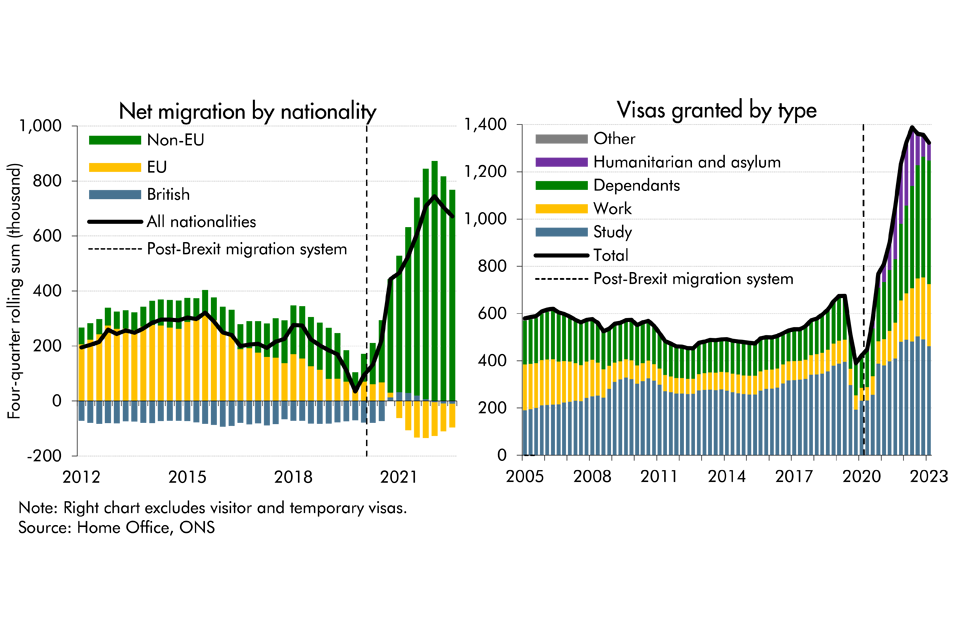
In January, the ONS published updated net migration projections which assume net inflows follow a linear path downward from the latest outturn of around 670,000 in the year to mid-2023 to a medium-term level of 315,000 from 2027-28. This is 70,000 higher than the steady state level of 245,000 assumed in their last set of projections and used in our November 2023 forecast. The ONS based this new assumption on a 10-year historical average to mid-2023, with the choice of horizon reflecting consultation with an expert panel. a
We use the new ONS medium-term net migration projection as the end point of our five-year forecast. While there remains considerable uncertainty about this projection, we judge that it is a reasonable estimate of the steady state level of net migration informed by consultation with migration experts. However, we have adjusted the near-term path of net inflows to incorporate a sharper short-term decline than the ONS straight-line path (Chart D). This reflects two factors:
- First, the recent rise in immigration, especially among students, should lead to higher emigration in the short term. b
- Second, immigration policy changes announced shortly after our November 2023 EFO will likely significantly reduce inflows in the near term. c The Home Office estimated those policies, together with those previously announced in May 2023, would cut immigration by 300,000 (mostly among dependants) under a hypothetical scenario where they were applied in the year to September 2023. d Most of the policies will have been introduced by April 2024, so we expect significantly reduced immigration levels from that point.
This means we now expect net migration to average around 350,000 a year over the forecast period, up from 290,000 in our November forecast. Cumulatively, this adds a further 350,000 people (around 300,000 adults) to the UK population over the next five years. However, these estimates are highly sensitive to alternative assumptions for future immigration levels, the share of previous immigrants that stay in the UK and the impact of government policy.
Chart D: Net migration forecast and scenarios

In constructing our economic forecast, we estimate that migrants coming to the UK over our forecast period have a slightly higher average participation rate than the adult UK resident population over our five-year forecast. This reflects a combination of three factors:
- Age : Migrants are more likely to be of working age (16-64) when they arrive.
- Composition : The post-Brexit composition of migrants has shifted more towards groups that have historically had lower participation rates (e.g. students and dependants). However, those groups have seen rising participation rates under the new migration system. For example, LFS data suggest that migrants coming to the UK to study are now more likely to be economically active, with their participation rate increasing from 30 per cent in 2019 to 48 per cent in the year to June 2023. e This is likely the result of the graduate route making it easier for students to enter the labour market after their studies.
- Dynamics : In the medium term, the longer migrants stay, the more likely they are to participate. While this tends to reverse after 10 years, that is beyond our forecast horizon.
Given the uncertainty around future migration flows, we explore two alternative scenarios where net migration is 200,000 higher or lower in the medium term and the total population in 2028-29 is one million higher or lower than in our central forecast (Chart D). f In each scenario, we explore the implications of alternative assumptions for migrants’ productivity and participation in the labour force.
In the high migration scenario , net migration falls by around 160,000 from its current level to settle at 515,000 a year in 2028-29. Looking at its potential economic implications:
- The blue bars assume the additional migrants have the same productivity per hour worked as the existing population. g This could reflect either investment responding so capital per worker is unchanged, or lower capital per worker offset by higher TFP growth. We also assume additional migrants have the same participation rate as the existing population. Based on these assumptions, GDP is 1.5 per cent higher in 2028-29, but GDP per person is largely unchanged.
- The yellow triangles show what would happen if the capital stock did not adjust at all in response to higher migration, making less capital available per worker and reducing overall productivity. GDP in 2028-29 is still higher but by a smaller amount (1 per cent), but GDP per person is then 0.4 per cent below our central forecast.
- The green diamonds show the impact of assuming additional migrants have a much higher participation rate than the adult UK population (around 90 rather than 63 per cent), consistent with a scenario where almost all adults arrive on work visas. This boosts the impact on GDP to 2.2 per cent in 2028-29 and raises GDP per person 0.8 per cent above our forecast.
The impacts in the lower migration scenario, in which net migration settles at 115,000 in 2028-29, are symmetric. These scenarios show that while additional (fewer) migrants generally boost (reduce) the level of aggregate output in the economy, the size of this impact and the effect on per person living standards is highly uncertain. The age, education, skill level, and participation rate of migrants, alongside the investment response of businesses, are all factors that determine the impact of migration on per person output. We explore the fiscal implications of net migration in Chapter 4.
Chart E: Real GDP and real GDP per person differences from our central forecast

This box was originally published in Economic and fiscal outlook – March 2024
a The panel meeting took place on 12 December 2023, after the Government’s latest migration policies were announced. b This is consistent with recent academic literature, as in: Hall, T., A. Manning and M. Sumption, Projecting UK net migration , Centre for Economic Performance, Occasional Paper No.60, October 2023. c These policies included: restricting social care workers from bringing dependants; requiring social care firms to be Care Quality Commission (CQC) registered to sponsor visas; raising the salary threshold for skilled worker visas; changes to the shortage occupation list; and raising the minimum income required for family visas. These were in addition to previously announced policies that restricted the majority of students from bringing dependants. d Home Office, Legal migration statement: estimated immigration impacts , 21 December 2023. e Based on LFS data shown in Box 2.3 in our November 2023 Economic and fiscal outlook . f In line with the ONS projections, we have assumed around 85 per cent of those arriving are aged 16 or older. g See Migration Advisory Committee, A points-based system and salary thresholds for immigration , January 2020, which concluded “the evidence base on the impact of migration on productivity is not as strong as it is for other areas of impact… the MAC view is that there is no strong evidence for there being large effects” .
Related content.
- Forecast in-depth: Adult population
- Download data
Privacy Overview
The Migration Observatory informs debates on international migration and public policy. Learn more about us
- Publications
- Press & Commentary

Home / publications / commentaries /
Why the government’s economic Impact Assessment of the Illegal Migration Act tells us little about the Act’s economic impact
26 Jul 2023
by Peter William Walsh & Madeleine Sumption
In July 2023, Parliament passed the Illegal Migration Act (IMA) 2023 . The Act prevents most people who arrive in the UK without authorisation from receiving a decision on their asylum claim.
In June 2023, the Home Office published its long-awaited Impact Assessment (IA) of the then Bill, which focused on economic costs. IAs are often one of the few places in which the government lays out expectations on the concrete impacts of proposed legislation in any detail, and so, in theory, provide an important source of information for understanding the policy measures.
This briefing note reviews the Impact Assessment. It concludes that:
- There are such large gaps in the Impact Assessment that it tells us very little about the overall economic impact of the Act. As a result, the numbers in it should be used with great caution.
- The IA does not assess the economic impacts of the central policy in the Act—namely, preventing those who arrive through irregular routes from receiving asylum decisions. It assesses a somewhat different plan: the cost of relocating asylum seekers to third countries like Rwanda.
- The Home Office estimates suggest that it costs more to relocate asylum seekers to Rwanda than to process their claims in the UK, primarily because the estimated payments to the government of Rwanda for each person they accept are much higher than previous public statements suggested they would be.
- Important questions that will crucially affect the impacts of the Act remain unresolved. These include what the government intends will happen to people who come to the UK without authorisation but cannot be removed (for example, because there is no safe country to remove them to); how long it plans to detain people affected by the Act, particularly if they remain in the UK for long periods; and whether people in this situation will ever have their legal status resolved.
For more information on the Illegal Migration Act itself, see the Migration Observatory briefing note, UK policies to deter people from claiming asylum .
A partial assessment
Economic costs or benefits typically play only a secondary role in public debates about the merits of policies towards refugees and asylum since the primary purpose of the policies is not economic. However, one of the main arguments the government has made in favour of the Act has been that it will reduce the growing cost of the asylum system in the UK.
The Impact Assessment (IA) is unusual in that it does not contain an economic cost-benefit analysis of the Act as a whole . The economic impact of the Act hinges primarily on how many people it deters from coming to the UK through irregular routes, and the IA does not attempt to estimate this. Nor does it estimate the costs of financially supporting people who cannot be removed and who may remain in the UK indefinitely without immigration status and without the right to work—one of the main costs the Act is expected to create.
One reason for these omissions is that, as the IA points out, the Act is a “novel and untested scheme”, which makes a full economic assessment effectively impossible. However, it is important to remember when using any of the figures from the Impact Assessment that it does not actually tell us much about the overall economic impact of the Act.
Instead, the IA estimates the approximate cost of removing each individual to a safe third country, such as Rwanda. In this context, a ‘third country’ refers to a country that is neither the country from which an asylum seekers has fled nor the country in which they are seeking asylum (i.e., the UK).
The financial calculation
Estimating the financial impact of any policy requires a counterfactual: what the cost would be if the policy were not implemented. For this, the IA assumes that without the new policy, individuals would not be relocated and would be supported in the UK while their asylum claims are processed.
Costs of relocating asylum seekers to other countries
The IA estimates that the cost of sending one person to a safe third country would be £169,000 . This figure comes with caveats.
The largest part of this cost is the UK’s per-person payment to the recipient third country, given as £105,000. However, the IA does not reveal the actual amount the UK has agreed to give to Rwanda because it is “commercially sensitive”. Instead, it uses another (largely irrelevant) figure: a 2016 National Audit Office estimate of the cost of supporting a refugee in the UK under the UK’s Syrian resettlement programme, the Vulnerable Persons Resettlement Scheme.
Presumably, this figure has been chosen because it is similar to the actual per-person payment that will be sent to the government of Rwanda. Otherwise, the entire IA exercise would be rather meaningless.
Members of the government had previously suggested that the per-person payments to Rwanda would be “ comparable ” to processing them in the UK, which had been said to be around £12,000 per individual.
The total £169,000 figure, which also factors in Home Office administrative costs and the cost of flights, also includes a 9% ‘optimism bias’, to recognise a systematic tendency to underestimate costs in impact assessments.
Costs of supporting asylum seekers in the UK instead of relocating them overseas
The IA then compares the cost of relocating each person with the cost of supporting them in the UK while their asylum claim is decided. It estimates that supporting a person under the current asylum system would cost £106,000 . This figure thus represents the estimated cost saving of relocating each person overseas. This estimate includes accommodation and support costs but does not appear to include not the cost of processing a person’s asylum claim or their use of public services during the period their asylum claim is pending.
The £106,000 figure is based on the assumption that without the Illegal Migration Act, a person would be supported in the UK for four years while their asylum claim is processed. This seems surprisingly long. In Q2 2022, the median wait time for people to receive initial decisions on their asylum claims was roughly 2 years, and 12% of people had waited for three years or more (Figure 1). Currently, around three-quarters of initial decisions are positive, so there are relatively few appeals—although where appeals do happen, they can add substantial time to the overall process.
Long asylum waiting times are not inevitable: as recently as 2017, a majority of asylum applicants received an initial decision within six months.
In the IA’s model, the four-year assumption increases the total per-person cost of not removing people and processing their asylum claims and hence reduces the net per-person cost of relocating asylum seekers to third countries. The cost-effectiveness of third-country removals, therefore, depends to some extent on the idea that the government cannot fix long asylum wait times. Somewhat perversely, if the government is successful in reducing asylum wait times—which have been a major driver of the cost of the current system—third-country relocations become less cost-effective.

On the other hand, the IA does not consider the long-term net fiscal impact of people who would settle in the UK permanently as refugees under the current system. (Under the Act, the claims of these individuals would not be heard.)
There is not much research on the net fiscal impact of refugees, perhaps because the reasons for admitting them are not economic. However, employment rates of refugees are low on average (see also Figure 2), and employment rates are one of the most important drivers of fiscal impact. It is thus reasonable to assume that there is a net fiscal cost of supporting refugees in the UK over the course of their lifetimes. While the fiscal impact of migration to the UK is small , refugees are therefore less likely than other migrants to be among those who make net fiscal contributions (i.e. to pay more into government finances through tax and other contributions than it costs to provide them with benefits and public services).

Government data on income tax and national insurance contributions show that in fiscal year 2019-20, people from countries associated with higher refugee flows to the UK, such as Syria or Afghanistan, were less likely than people from other countries to pay more in tax and national insurance than the cost of HMRC-administered benefits.
The IA does make reference to the long-term prospect of a net fiscal cost but does not attempt a full fiscal analysis.
Net cost of relocating asylum seekers overseas
Overall, the IA thus estimates that the net per-person cost of relocating each asylum seeker to third countries such as Rwanda is £63,000 . In other words, removing a person to Rwanda is £63,000 more expensive than supporting that person throughout their asylum process in the UK (Table 1), according to the Home Office estimates.
Table 1: The Impact Assessment’s estimated per person cost of relocation to third countries
Source: Home Office Impact Assessment, Illegal Migration Bill. Notes: (1) Assumed to be equal to the Syrian resettlement 5-year cost per refugee, uplifted from 2016/17 prices to 2023/24 prices. (2) Assumes fifty people per flight.
Because the IA estimates that it is more expensive to send asylum seekers to Rwanda than process them in the UK, any estimate of the cost of the relocation policy depends in large part on how many people would be deterred by it.
The IA does not estimate this deterrent effect, except to say that there is “little to no evidence suggesting changes in a destination country’s policies have an impact on deterring people from leaving their countries of origin or travelling without valid permission”. The IA does cite some interesting international examples of cases where policies may have reduced irregular migration: Australia, Spain, Italy, the EU, Scandinavia, and the UK with regard to Albanian arrivals. However, with the partial exceptions of Australia and UK-Albania, all the cases are examples of enforcement measures that physically prevent irregular arrival, such as boat interceptions and pushbacks, and not deterrence measures of the type contained in the Act.
Nonetheless, the IA estimates the cost saved for each person deterred from entering the UK irregularly. This figure is given as £106,000: that is, the same as the cost (estimated above) of supporting someone in the UK for four years following an asylum claim.
The IA calculates that for every 1,000 people who might have entered the UK without authorisation, 37% need to be deterred from coming for the government to recoup the net cost of removing the remaining 63%. Note that this is not the same as saying that irregular migration must fall by 37%, but rather that, for the government to break even, 37 people must be deterred for every 63 who are relocated. However, this comparison makes little sense without considering a third, crucial group of people: those who are neither deterred nor relocated.
A missing third group: people who are not removed
In examining the per-person cost of removing an individual to a safe third country, the IA makes no assumptions about how many people will be removed or how many will be deterred in total. As such, it does not give any consideration to a crucial third group: people who still come to the UK and cannot be removed (e.g., because of insufficient capacity to send them to third countries like Rwanda) and who are therefore detained or supported in the UK indefinitely. At the time of writing, the Court of Appeal had recently ruled that the UK could not remove asylum seekers to Rwanda, although the Supreme Court’s stance on this question was not yet known.
If the group of people neither deterred nor removed is large, the costs of supporting them would be a major driver of the Act’s fiscal impact. This may especially be the case if the government decided to detain people rather than support them in something equivalent to current asylum accommodation. Building new detention capacity has costs, and holding people in detention is more expensive than providing them with regular accommodation (see below). The Act implies an increase in detention, given the numbers of people arriving through irregular routes to claim asylum (tens of thousands of people per year). The detention estate’s capacity was around 2,500 in 2022, and as of 31 March 2023, around 1,600 people were in detention.
How much would it cost to support this third group of those neither deterred nor deported? The IA assumes a cost of £85 per day to support someone in accommodation, and in Q1 2023, the cost of holding someone in immigration detention was estimated at around £113 per day . This implies an annual cost of supporting someone in asylum accommodation of around £31,000 per person per year, and more if long periods of detention are involved. Unlike the IA figures for people who are either deterred or relocated (where the costs are incurred either once or for four years), these figures would be accrued each year for an indefinite period. Unless the government found a way to resolve the cases of people in this situation, the long-term cost of supporting them could become quite high.
Concluding remarks
Calculating the financial implications of complicated policies is exceedingly difficult. This is especially the case when a policy is novel, untested, and has yet to be implemented. While a fuller accounting of the Illegal Migration Act’s implementation costs may be possible in time, it is likely that the overall economic impact will never be possible to assess properly because the number of people deterred will not necessarily be clear.
Asylum applications go up and down for different reasons. It will not be easy to disentangle the deterrent effect asylum policies from the range of other factors that affect the number of people crossing the Channel, such as geopolitical developments or operational cooperation on enforcement (e.g., with France or Albania) that are not part of the policy package proposed in the Act. In Australia, for example, there is still substantial debate about whether deterrence policies or physical enforcement (pushbacks at sea) were primarily responsible for the large decline in boat arrivals.
If the number of people crossing the channel in small boats declines in future, we will not necessarily know how much is due to the Act. If it does not decline, we will not know whether the number would have been even higher without the new policy.
In other words, because the government’s position is that it is cheaper to keep people in the UK than send them to Rwanda, the cost-effectiveness of the Illegal Migration Act will depend fundamentally upon its deterrent effect. And it is quite possible that the size of this effect will never be known.
This research was made possible thanks to the support of Oak Foundation . Special thanks go to CJ McKinney for detailed comments on a draft of this briefing note.
Press Contact
If you would like to make a press enquiry, please contact:
+ 44 (0)7500 970081 [email protected]
Browse all analysis
View all briefings, primers, commentaries and reports
Contact Us
General Enquiries
T: +44 (0) 1865 612 375 E: [email protected]
Press Enquiries
T: +44 (0)7500 970 081 E: [email protected]
- Newsletter sign up
- Follow us on twitter
- Like us on facebook
- Watch us on vimeo
Connections
This Migration Observatory is kindly supported by the following organisations.
- Accessibility
- Privacy Policy & Cookies
The Migration Observatory, at the University of Oxford COMPAS (Centre on Migration, Policy and Society) University of Oxford, 58 Banbury Road, Oxford, OX2 6QS
- © 2024 The Migration Observatory
- Website by REDBOT
To provide the best possible experience, this website uses cookies. By clicking 'Accept All' you accept our use of cookies.
Necessary Cookies
Necessary cookies are always on and are required to enable core functionality such as secure login. They don't contain personally identifiable data.
Analytical Cookies
Analytical cookies help us understand how visitors interact with our website, providing metrics such as the number of visitors and page views.
Home — Essay Samples — The Impact Of Immigrants On The Uk
The Impact of Immigrants on The UK
About this sample

Words: 892 |
Published: Oct 25, 2021
Words: 892 | Pages: 2 | 5 min read
Table of contents
The current situation of immigration in the uk, reasons for immigration to the uk, personal view on immigration, cite this essay.
Let us write you an essay from scratch
- 450+ experts on 30 subjects ready to help
- Custom essay delivered in as few as 3 hours
Get high-quality help

Dr Jacklynne
Verified writer

+ 120 experts online
By clicking “Check Writers’ Offers”, you agree to our terms of service and privacy policy . We’ll occasionally send you promo and account related email
No need to pay just yet!
Remember! This is just a sample.
You can get your custom paper by one of our expert writers.
121 writers online
Still can’t find what you need?
Browse our vast selection of original essay samples, each expertly formatted and styled
Related Topics
By clicking “Send”, you agree to our Terms of service and Privacy statement . We will occasionally send you account related emails.
Where do you want us to send this sample?
By clicking “Continue”, you agree to our terms of service and privacy policy.
Be careful. This essay is not unique
This essay was donated by a student and is likely to have been used and submitted before
Download this Sample
Free samples may contain mistakes and not unique parts
Sorry, we could not paraphrase this essay. Our professional writers can rewrite it and get you a unique paper.
Please check your inbox.
We can write you a custom essay that will follow your exact instructions and meet the deadlines. Let's fix your grades together!
Get Your Personalized Essay in 3 Hours or Less!
We use cookies to personalyze your web-site experience. By continuing we’ll assume you board with our cookie policy .
- Instructions Followed To The Letter
- Deadlines Met At Every Stage
- Unique And Plagiarism Free
- Work & Careers
- Life & Arts
Become an FT subscriber
Try unlimited access Only $1 for 4 weeks
Then $75 per month. Complete digital access to quality FT journalism on any device. Cancel anytime during your trial.
- Global news & analysis
- Expert opinion
- Special features
- FirstFT newsletter
- Videos & Podcasts
- Android & iOS app
- FT Edit app
- 10 gift articles per month
Explore more offers.
Standard digital.
- FT Digital Edition
Premium Digital
Print + premium digital, ft professional, weekend print + standard digital, weekend print + premium digital.
Essential digital access to quality FT journalism on any device. Pay a year upfront and save 20%.
- Global news & analysis
- Exclusive FT analysis
- FT App on Android & iOS
- FirstFT: the day's biggest stories
- 20+ curated newsletters
- Follow topics & set alerts with myFT
- FT Videos & Podcasts
- 20 monthly gift articles to share
- Lex: FT's flagship investment column
- 15+ Premium newsletters by leading experts
- FT Digital Edition: our digitised print edition
- Weekday Print Edition
- Videos & Podcasts
- Premium newsletters
- 10 additional gift articles per month
- FT Weekend Print delivery
- Everything in Standard Digital
- Everything in Premium Digital
Complete digital access to quality FT journalism with expert analysis from industry leaders. Pay a year upfront and save 20%.
- 10 monthly gift articles to share
- Everything in Print
- Make and share highlights
- FT Workspace
- Markets data widget
- Subscription Manager
- Workflow integrations
- Occasional readers go free
- Volume discount
Terms & Conditions apply
Explore our full range of subscriptions.
Why the ft.
See why over a million readers pay to read the Financial Times.
International Edition
Cookies on GOV.UK
We use some essential cookies to make this website work.
We’d like to set additional cookies to understand how you use GOV.UK, remember your settings and improve government services.
We also use cookies set by other sites to help us deliver content from their services.
You have accepted additional cookies. You can change your cookie settings at any time.
You have rejected additional cookies. You can change your cookie settings at any time.
- Entering and staying in the UK
- Immigration rules
Migration numbers fall further as measures have major impact
Government action cuts migration on key routes by 25% in the first 4 months of 2024, compared to the same period in 2023.

Visa applications across key routes have fallen by a quarter in the first 4 months of 2024, as the Home Secretary’s package to reduce unsustainable migration continues to deliver.
Government measures to tighten student visas, which came into force in January, have prevented most international students starting courses this year from bringing family members with 79% fewer student dependent applications in the first 4 months of 2024. Students can also no longer switch their visa before completing their course, preventing people using the route as a backdoor to work in the UK, while clamping down on institutions which undermine the UK’s reputation by selling immigration not education. There were more than 30,000 fewer student visa applications made between January to April 2024 compared to the same period in 2023.
Data also shows that in the first full month the restrictions on care worker dependants were in place, there was a 58% fall in Health and Care dependant application numbers, from 15,100 in April 2023 to 6,400 in April 2024. The government has been clear that the unprecedented rise in care worker dependant visa numbers had been both disproportionate and unsustainable. Together with efforts to crack down on abuse, through our changes requiring firms sponsoring migrant care workers in England to be CQC registered, we are determined to see these numbers continue to fall.
Today’s monthly visa figures come ahead of the ONS’s net migration stats for the year ending December 2023 being published tomorrow and the government’s quarterly immigration statistics for the year ending March 2023. However, the ONS figures do not take into account the major package measures announced in December which have already started to have an effect.
Today’s monthly data provides an up to date picture of visa applications across key routes, with early signs that the government’s tough measures are reducing legal migration.
Home Secretary James Cleverly said:
The plan to deliver the largest ever cut to legal migration in our country’s history is working. This monthly data is the most up to date picture of visa levels, showing that on current trajectories legal migration continues to fall across key routes. The British people deserve an immigration system that puts their interests first. Our approach is about control and fairness; to the highly skilled coming here who deserve a decent wage, to taxpayers who shouldn’t be relied on to support them, and to British workers who shouldn’t be undercut. We will continue to keep these measures under close review and if needed, we will not hesitate to go further.
Taken together, the Home Secretary’s package to reduce legal migration will mean approximately 300,000 people who arrived in the UK last year would no longer be able to. It includes:
- increasing the salary threshold for Skilled Worker visas by 48% to £38,700
restricting care workers from bringing dependants with them and requiring care providers acting as sponsors in England to register with the industry regulator, the Care Quality Commission (CQC), to crack down on worker exploitation and abuse within the sector
abolishing the shortage occupation list and replacing it with a new immigration salary list, with employers no longer able to pay migrants less than UK workers in shortage occupations
- raising the minimum income requirement for the family visa to reach the level of the Skilled Worker visa, currently £38,700 by early 2025
Delivery of this comprehensive series of measures is part of the government’s wider plan to crack down on rising migration, both legal and illegal, and reform the immigration system. The plan is working, with small boats crossings down by around a third last year, and work continues to tackle this global challenge including by working with international partners and clamping down on the criminal gangs with stepped up enforcement.
It comes as the government continues a programme of work to grow and support the domestic social care workforce. Led by the Department of Health and Social Care, this includes better training, clearer career paths and improved job prospects through a new accredited qualification. The Department for Work and Pensions has also announced plans this week to see unemployed Brits filling roles once filled by foreign workers, to help build our domestic workforce and reduce reliance on cheap overseas labour.
Now that the Safety of Rwanda Act has passed and the treaty with Rwanda has been ratified, the government is entering the final phase of operationalising this landmark policy, with the first flight set to take off to Rwanda in early July.
Share this page
The following links open in a new tab
- Share on Facebook (opens in new tab)
- Share on Twitter (opens in new tab)
Is this page useful?
- Yes this page is useful
- No this page is not useful
Help us improve GOV.UK
Don’t include personal or financial information like your National Insurance number or credit card details.
To help us improve GOV.UK, we’d like to know more about your visit today. Please fill in this survey (opens in a new tab) .
General election latest: Starmer gives blunt response on potentially rejoining EU - as police drop investigation into his deputy
Greater Manchester Police will take no further action after an investigation into Labour's Angela Rayner. Meanwhile, Rishi Sunak continues to sing the virtues of his national service policy proposal.
Tuesday 28 May 2024 22:00, UK
- General Election 2024
Please use Chrome browser for a more accessible video player
Election news
- Abbott given back Labour whip
- Police drop Rayner investigation | Labour deputy hits out at Tories
- Explained: What Starmer's deputy was being investigated for
- Starmer: 'No case' for rejoining EU | Reeves won't rule out tax rises
- Daily Podcast: How long will Labour's promise on taxes last?
- Live reporting by Faith Ridler and (earlier) Ben Bloch
Expert analysis
- Gurpreet Narwan: Farage already has eyes on elections to come
- Adam Boulton: What makes this election particularly exciting
- Sam Coates: Labour could have difficult decisions to make
Election essentials
- Trackers: Who's leading polls? | Is PM keeping promises?
- Campaign Heritage: Memorable moments from elections gone by
- Follow Sky's politics podcasts: Electoral Dysfunction | Politics At Jack And Sam's
- Read more: What happens next? | Which MPs are standing down? | Key seats to watch | How to register to vote | What counts as voter ID? | Check if your constituency's changing | Sky's coverage plans
It's 10pm - here's your late night run-down.
We're still in the early days of the election campaign, but there has been plenty of divisive policy announcements, clashes and political stunts making a splash here in the Politics Hub.
Let us get you up to speed on everything you may have missed...
- Diane Abbott, the MP for Hackney North and Stoke Newington, has been handed back the Labour whip today, Sky News understands;
- She was suspended by the party more than a year ago after suggesting Jewish people did not experience racism, but rather prejudice similar to red heads. The MP swiftly apologised and withdrew her remarks;
- The Tories have lost a key attack line after news that Labour's deputy leader Angela Rayner will face no further action in an investigation over her living arrangements;
- The Labour frontbencher criticised the Tories for "reporting political opponents to the police during election campaigns to distract from their dire record". As a reminder, the investigation was launched after Tory MP James Daly complained about her to police;
- Rishi Sunak was in the East Midlands, where he defended a Conservative plan to introduce the "triple lock plus". This will essentially result in a tax cut for pensioners by raising their tax-free allowance by either average earnings, inflation or by 2.5% - whichever is higher;
- However, it should be noted it was the decision of a previous Tory government to freeze income tax thresholds, bringing more people into paying the tax, including on income from pensions;
- Labour have been busy outlining their economic plans, but challenged by our deputy political editor Sam Coates , would-be chancellor Rachel Reeves refused to rule out further tax rises if Labour finds a black hole in the public finances;
- Meanwhile, over in the Liberal Democrat camp, the party's leader Sir Ed Davey fell off a paddleboard numerous times in Windermere today - but has admitted one of the plunges was intentional.
If you've got a bit more time on your hands, you can read more of some of the stories above in greater detail:
Stick with us for all the latest throughout the evening.
Sir Keir Starmer has pledged cut NHS waiting lists from day one, telling hospitals to immediately establish new clinics on evenings and weekends.
The Labour leader has pledged that 40,000 appointments per week will be rapidly rolled out, by sending staff from Guy's and St Thomas's NHS Foundation Trust to help set up high intensity schemes.
These teams have already "proven they can get their high intensity theatre lists on weekends up and running within six weeks", Labour said.
Sir Keir added: "It was NHS staff working in the hospital I can see from my office in parliament who led the way on this new model.
"Labour will take the best of the NHS to the rest of the NHS, so patients in every part of the country can be treated on time.
"The NHS is personal to me. It runs through my family.
"That's why I'm utterly committed to reforming this service, getting the NHS back on its feet, and making it fit for the future."
After a bumpy start to the Tory election campaign, day six has been somewhat smoother for Rishi Sunak.
That's not to say the Conservative election machine isn't on the lookout for potential missteps though.
During a TV interview in the changing room of a bowls club in Leicestershire, a hat was strategically placed to cover a name tag adorned with the blush-worthy surname "Glasscock".
While at a homeware factory in Staffordshire, a Tory aide spotted and swiftly removed a can of Monster energy drink from a worktop where the prime minister was about to inspect some ceramics.
Amid a slanging match over leaders taking 'duvet days' early in the campaign, a photo of the Tory leader next to a giant caffeine-stuffed beverage is probably not the message the party wants to send out.
You can read more from Sky News below:
What are the rules on voter ID? How does tactical voting work? In what different ways can you cast your ballot?
The countdown to the election is on - and already the amount of information can seem overwhelming.
We cut through the noise to bring you what you need to know, from registering to vote, to election day and what happens next.
Read on here...
We're still very much in the early days of the election campaign - but policy announcements are coming in thick and fast from the main two parties.
Here's a breakdown of what we've heard so far...
The Conservative Party
National service - The Conservatives have vowed to bring back a "modern" form of national service for 18-year-olds in the UK, which could involve military service of volunteer work.
'Triple lock plus' - The party has promised to cut taxes for pensioners by creating a new "age-related" tax-free allowance - dubbed "triple lock plus". In short, a pensioner's allowance would rise in line with either average earnings, inflation or by 2.5% - whichever is higher - from next April.
Education - The Tories have promised to create a new qualification framework called the Advanced British Standard for those aged 16 to 18. The party also proposed making "some form" of maths and English compulsory up to the end of school.
Environment - Rishi Sunak has said he remains committed to plans to reach net zero by 2050, a goal adopted under Theresa May in 2019.
The Labour Party
Taxation - Labour has pledged not reverse the two recent cuts to national insurance - and not to increase income tax.
Economy - Two flagship economic pledges from Labour are the abolition of the non-dom tax status held by some wealthy foreign nationals, and the introduction of VAT to private school fees.
Waiting lists - The party has said it will get the NHS "back on its feet" by delivering 40,000 more evening and weekend appointments per week.
Environment - A major policy pushed by Labour is the formation of Great British Energy, which would be publicly owned. The party claims this would reduce household energy bills and create jobs.
Education - Also a headline policy from Labour is a plan to recruit around 6,500 new teachers in key subjects - and create a "national excellence programme" to support professional development.
Until voters go to the polls on 4 July, the Politics Hub will be looking back at some memorable moments from previous general election campaigns.
The big winner from the UK's first ever TV prime ministerial debate in 2010 wasn't primary contenders David Cameron and Gordon Brown.
No, it was Nick Clegg.
As the Tory and Labour leaders looked to take chunks out of one another, they saved their more conciliatory side for the insurgent Lib Dem.
He could do no wrong that night, with Messrs Cameron and Brown both finding it completely irresistible not to simply "agree with Nick".
Cleggmania took him all the way into Number 10 as part of the coalition, where he stayed until his party was turfed out by voters in 2015.
Previous entry: The Prescott punch
By Gurpreet Narwan , political correspondent
Recent polling suggests Reform could cost the Tories as many as 100 seats, paving the way for a Labour government by splitting the right.
It's something Tory MPs are highly anxious about and explains why the Conservatives are pushing the following message hard: a vote for Reform is a vote for Labour.
It's a tactic they deployed against the Liberal Democrats in 2015, warning voters that they had a choice between Ed Miliband and David Cameron.
Farage had a comeback ready in Dover today.
In stark contrast to Richard Tice, leader of Reform UK, he conceded the election result was a foregone conclusion.
"Labour have won, so why not vote for something you believe in," he said.
He argued this campaign wasn't about the current election but about building the Reform movement, a process that could take six years and was focused on turning the party into a sustainable force on the right of British politics.
This is something parties to the right of the Tories have not managed. He wants to determine the shape of conservative opposition in the UK.
That could also have an impact on the direction of travel that the Conservative Party takes after the election.
It was the most salient point to emerge from today's campaign event.
We end tonight's show with a new classic of the Lib Dem election stunt genre.
Sir Ed Davey fell off a paddleboard multiple times during a campaign stunt in Windermere - admitting one of his plunges into the water was intentional.
The Liberal Democrat leader said his leap into the cold waters of the Lake District was for the benefit of the cameras - but he "just kept falling in" after that.
Despite the footage causing a splash online, he stressed there was a "serious message" behind the stunt.
"Lakes like Lake Windermere are so precious," he said. "Our environment and our wonderful country is so critical to so many people.
"It's important for public health, it's important for the environment, it's important for the tourist economy."
That's it for tonight's Politics Hub With Sophy Ridge - the show will be back at the same time tomorrow.
Adam Boulton , Sky News's election commentator, is now joining Sophy Ridge to discuss his history covering general elections - starting in 1983.
This was the poll in which Margaret Thatcher was re-elected after winning the Falklands.
"I've covered I think 10 general elections," Adam says, pointing out the July election - for which he will join Sky News - will be his 11th.
But this only includes two changes of party in government, he says.
"What makes this election particularly exciting is the possibility, according to the opinion polls, that we're going to get another change in government."
Adam adds: "We had 17 or 18 years of Thatcher, and then 12 or 13 years of Blair and Brown, and now we've had 14 years from Cameron to Sunak."
If there is a change of party in July - what will this day look like?
"It's always very interesting," he says, explaining it is "quite emotional" because you see the "utter desolation of the side that's been defeated".
Adam is then asked how much a campaign can make a difference.
He says: "I just wonder how much difference this campaign is going to make to voting intention, it's clearly going to be very important in terms of formulating what the policies are for the parties, testing the leaders."
Adam adds this is an election in which "both leaders are not known quantities, neither of them have led a party into a general election before".
However, he says, another "exceptional thing" of this election is the amount of times the opinion polls have "said the same thing", which is Labour's on course for a majority.
Diane Abbott has been handed back the Labour whip, Sky News understands.
The MP for Hackney North and Stoke Newington was suspended by the party more than a year ago after suggesting Jewish people did not experience racism, but rather prejudice similar to red heads.
She swiftly apologised and withdrew her remarks.
While a Labour investigation into her comments ended in December, she was made to wait for the outcome.
A report in The Times earlier this evening suggested she'd been banned from standing for the party at the election on 4 July.
Ms Abbott was Britain's first ever black female MP.
It's not yet been confirmed whether she will stand for election again.
Labour's deadline for picking candidates is 4 June.
Be the first to get Breaking News
Install the Sky News app for free


IMAGES
VIDEO
COMMENTS
A Bank of England found a rise in immigration had a tiny impact on overall wages - with a 10% increase in immigration - wages fall by 0.31%. However, the negative effect was greater for semi/unskilled workers in the service sector, with a 10% rise in immigration reducing wages the equivalent of 2%. B of E report.
6 Apr 2018. Much public and policy concern has focused on the distributional impacts of immigration - in particular, potential negative impacts on employment and wages for low-skilled workers. This column summarises evidence and draws conclusions from the now considerable literature on the impact of migration to the UK on the economy and ...
I review trends in migration to the UK since the Brexit referendum, examining first the sharp fall in net migration from the EU that resulted, and then the recent more dramatic exodus of foreign-born residents during the covid-19 pandemic. I describe the new post-Brexit system, and review studies which attempt to estimate both the impact on ...
Portes Jonathan. 2018. "The Economic Impacts of Immigration to the UK" and "New Evidence on the Economics of Immigration to the UK," VoxEU (April and October, respectively). News summaries of the research evidence on the economic impacts of migration to the UK on jobs, wages, productivity, and more. Google Scholar.
restoring "control" over immigration on the other (UK in a Changing Europe, 2016). Since the referendum this has reversed - immigration has become a much less salient political issue, and public attitudes towards immigration have become more positive (Runge, 2019). However, its economic significance has become more apparent, first as
Forte, G and J Portes (2017), "The economic impact of Brexit-induced reductions in migration", Oxford Review of Economic Policy 33: S31-S44 Giuletti, G, and Z Yan (2018), "The Impact of Immigration on the Well-being of UK Natives". Goodhart, D (2017), The Road to Somewhere: The Populist Revolt and the Future of Politics, Hurst.
The tide on public sentiment towards immigration in the UK - and economists' views on Brexit's economic impact - may be turning. This column discusses the UK's post-Brexit migration system introduced in January 2021. It argues that the new system, while ending free movement with the EU and hence being far more restrictive for EU citizens moving to the UK for work, is considerably ...
Dustmann, C. and Frattini, T. "The Fiscal Effects of Immigration to the UK." Discussion Paper Series, CDP No 22/13, Centre for Research and Analysis of Migration, Department of Economics, University College London, 2013; Dustmann, C. and Frattini, T. "The Fiscal Effects of Immigration to the UK." The Economic Journal 124 (2014): F593-F643
The study finds that. The average UK-based migrant from Europe contributed approximately £2,300 more to UK public finances in 2016/17 than the average UK adult. In comparison, each UK born adult contributed £70 less than the average, and each non-European migrant contributed over £800 less than the average. The average European migrant ...
Immigration after Brexit. J. Portes. Political Science, Economics. National Institute Economic Review. 2016. This paper examines the short and long-term impacts of the UK referendum on migration flows and migration policy. Even in the short term - before any policy change - the vote will affect migration…. Expand. 31.
ABSTRACT What will be the long-run economic effects of the United King- ... immigration, and regulations. I mainly . 368 Brookings Papers on Economic Activity, Fall 2016
But even without such important reservations, the claim. count of the contribution to overall population growth by matters for national welfare is the increase in GDP per head, increase. In the year 2001-02 immigration increased the UK. 59.1 million by 0.25 percent, given net immigration from year of 149,000.
Abstract. We investigate the fiscal impact of immigration on the UK economy, with a focus on the period since 1995. Our findings indicate that, when considering the resident immigrant population in each year from 1995 to 2011, immigrants from the European Economic Area (EEA) have made a positive fiscal contribution, even during periods when the UK was running budget deficits, while Non‐EEA ...
For example, one UK study concludes that the main impact of increased immigration from 1975 to 2005 was on the wages of migrants already in the UK. The finding that negative impacts on wages fall primarily on people who migrated themselves is consistent with earlier research from the United States. Evidence gaps and limitations
Rising immigration has undoubtedly been one of the most significant demographic developments experienced by the United Kingdom over the past fifteen years. This article reviews the evidence on the effects of immigration on the UK labour market. On average, it seems that immigration has not had much of an effect on either employment or pay.
An Oxford Economics study 2018 found that Non-EEA migrants contributed a net negative of £800 compared to the average U.K.-based adult. They attributed this to the higher number of dependent children associated with Non-EEA migrants, which meant a higher cost to the state in terms of education. EEA migrants, however, were found to contribute a ...
THE IMPACT OF IMMIGRATION ON THE UK ECONOMY. osrian kargbo. 2021, issuu.com. This paper is ascribed to basically picture-out the benefits deriving/ derived from migrants and migration in UK. It aims to examine the role played by the immigration Department in UK's economy from immigrants. See Full PDF.
This boosts the impact on GDP to 2.2 per cent in 2028-29 and raises GDP per person 0.8 per cent above our forecast. The impacts in the lower migration scenario, in which net migration settles at 115,000 in 2028-29, are symmetric. These scenarios show that while additional (fewer) migrants generally boost (reduce) the level of aggregate output ...
How Immigration Affects the UK Economy. The main debate is to detect whether immigration has any adverse effects on the opportunities of natives in the United Kingdom, with many papers concerned with the subject of how immigration affects the economy looking into any impending effects. 2.1 Theoretical literature
About UK Essays; Our Expert Writers; Our Guarantees; Our Quality Procedures; Essay Buying Guide; ... The local labour market effects of immigration in the UK, C Dustmann et al, Home Office Online Report 06/03, 2003, p 9. ... Labour Market Institutions and the Effect of Immigration on EU Natives", Economic Journal, vol. 113, no. 488, June 2003 ...
Decent Essays. 1163 Words. 5 Pages. Open Document. Economic Effects of Immigration in the UK. Within the past ten years, immigration has tripled in the UK. The rising trend of immigration has led to a strongly negative perception towards foreigners within the British population. Economists have a more modest opinion on immigration; the economic ...
The Act prevents most people who arrive in the UK without authorisation from receiving a decision on their asylum claim. In June 2023, the Home Office published its long-awaited Impact Assessment (IA) of the then Bill, which focused on economic costs. IAs are often one of the few places in which the government lays out expectations on the ...
First, according to preliminary estimates, the total number of new immigrants in our country has exceeded 1.1 million since 1997, accounting for about 7% of the total population of our country. If the 2004 line, the previous annual increase of 145,000, and then rose to about 190,000. It is predicted that after 2007, the annual number of new ...
Essex estimates it contributes £792mn a year to the local economy and, with a long tradition in social sciences, has four courses in the UK top 10 for research quality, including international ...
Government action cuts migration on key routes by 25% in the first 4 months of 2024, compared to the same period in 2023.
The UK economy is approaching a soft landing, with a recovery in growth expected in 2024, strengthening in 2025. Growth was 0.6 percent q/q in 2024Q1, marking a stronger-than-expected exit from the technical recession in the second half of 2023, which left full-year growth at 0.1 percent.
Even though the essay question the Government gave the MAC was written to achieve a positive answer - emphasising the importance of the arbitrary target to attract 600,000 new foreign students ...
A fertility rate of 1.6 means that, without immigration, each generation will be a quarter smaller than the one before it. In 2000 rich countries had 26 over-65-year-olds for every 100 people aged ...
The state of the economy is why Labour won't match the Tory commitment to give pensioners a tax cut. "The reason pensioners are paying more tax at the moment is because of how the Conservatives ...